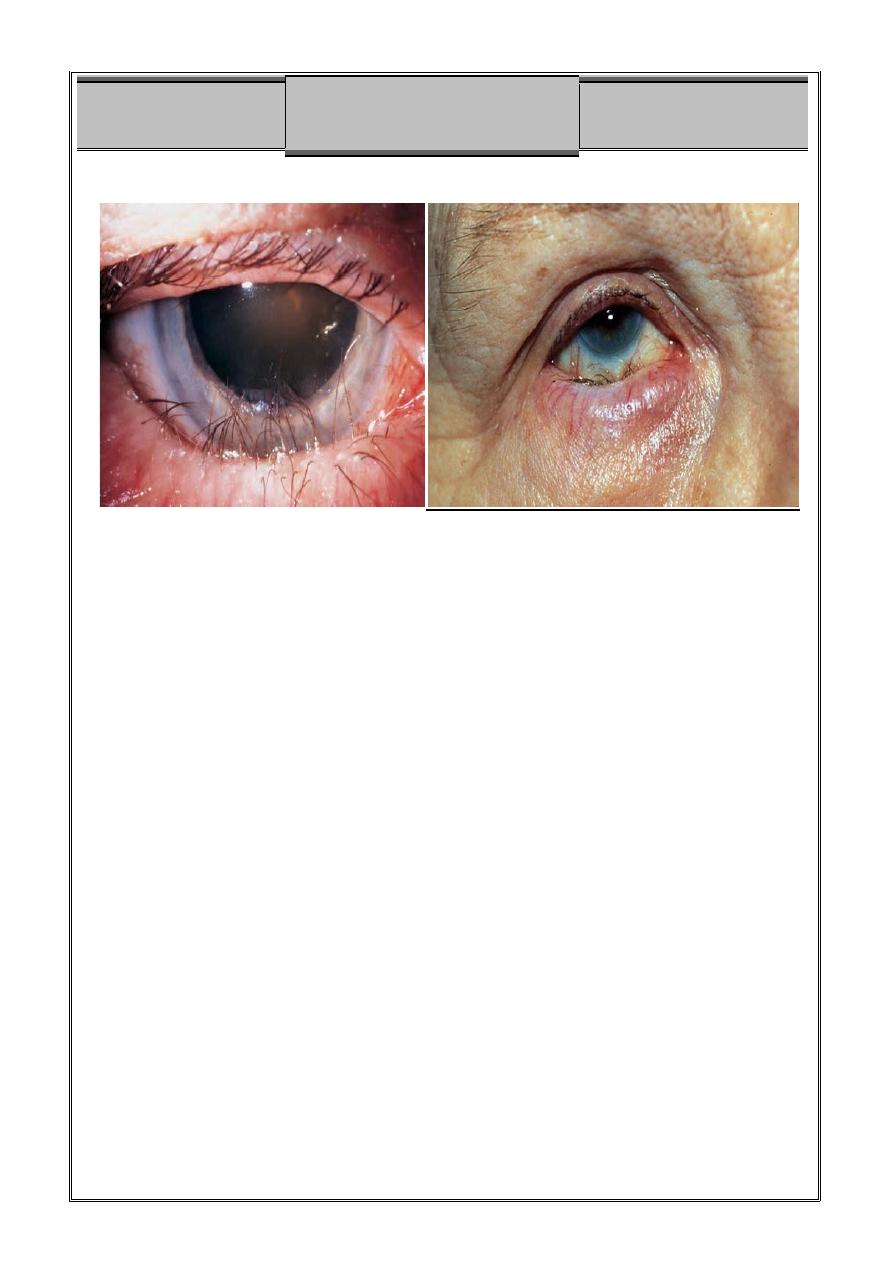
By : Saif S. Zaina
Clinical Ophthalmology
2013-2014
Diagnosis:
Entropion: Malposition (inward turning) of eyelid toward the eyeball
with trichiasis (misdirection of the eyelashes toward the eyeball).
Causes of entropion:
1) Congenital (rare).
2) Acute spastic conditions such as infections , inflammatory &
traumatic .
3) Cicatricial (scaring of the palpebral conjunctiva).
Causes of trichiasis:
1) Infections (trachoma , herpes).
2) Auto-immune (ocular cicatricial pemphigoid).
3) Inflammatory (Stevens-Johnson syndrome , vernal
keratoconjunctivitis).
4) Trauma.
Complications (entropion & trichiasis):
1) Infections.
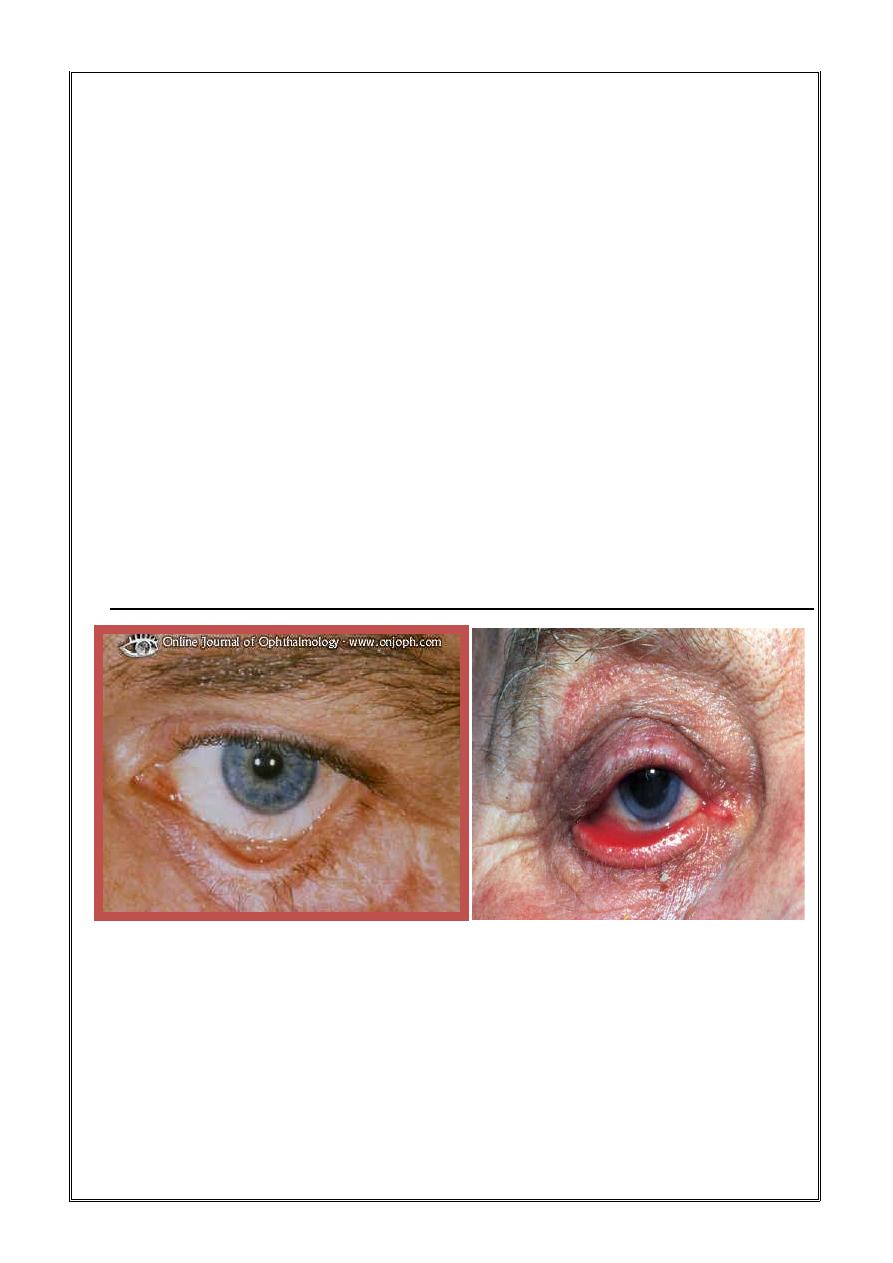
2) Corneal ulceration.
Treatment of entropion:
1) Eyelid hygiene.
2) Antibiotics to treat the causative microorganism.
3) Steroids.
4) Lubrication.
5) Small amount of botulinum toxin (BOTOX).
6) Surgical repair (Lateral canthotomy, lateral canthoplasty).
Treatment of trichiasis:
1) Treatment of the underlying disease (Stevens-Johnson syndrome &
ocular cicatritial pemphigoid).
2) Lubrication.
3) Treatment of infection.
4) Surgery (follicle destroying or lash/follicle repositioning).
Diagnosis:
Ectropion: Abnormal eversion (outward turning) of the lower eyelid
margin away from the globe.
Patient complaint:
Lacrimation.
Causes:
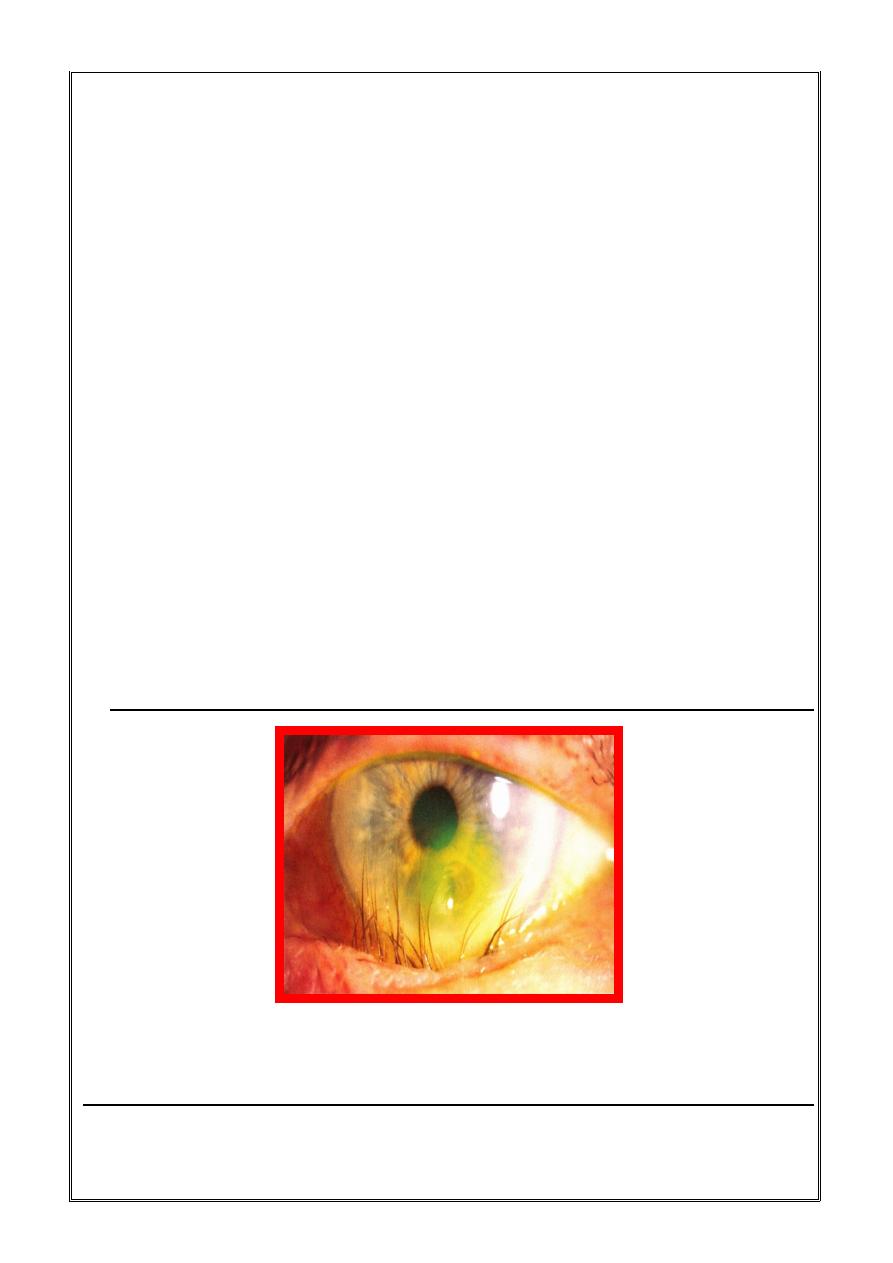
1) Congenital.
2) Acquired:
a) Senile.
b) Paralytic (facial nerve palsy).
c) Cicatricial (due to scar) such as burns , glaucoma drops and
chronic dermatitis ….etc.
d) Mechanical (tumour) such as neurofibromas.
Complications:
1) Conjunctival keratinization.
2) Corneal breakdown (ulceration)
3) Epiphoria (watery eye : tears flow onto the cheek).
4) Pain.
Treatment:
1) Treatment of infection (Chlamydia , herpes).
2) Lubrication.
3) Steroid.
4) Surgical repair (V to Y plasty or Z plasty).
Diagnosis:
Entropion with trichiasis & corneal ulceration.
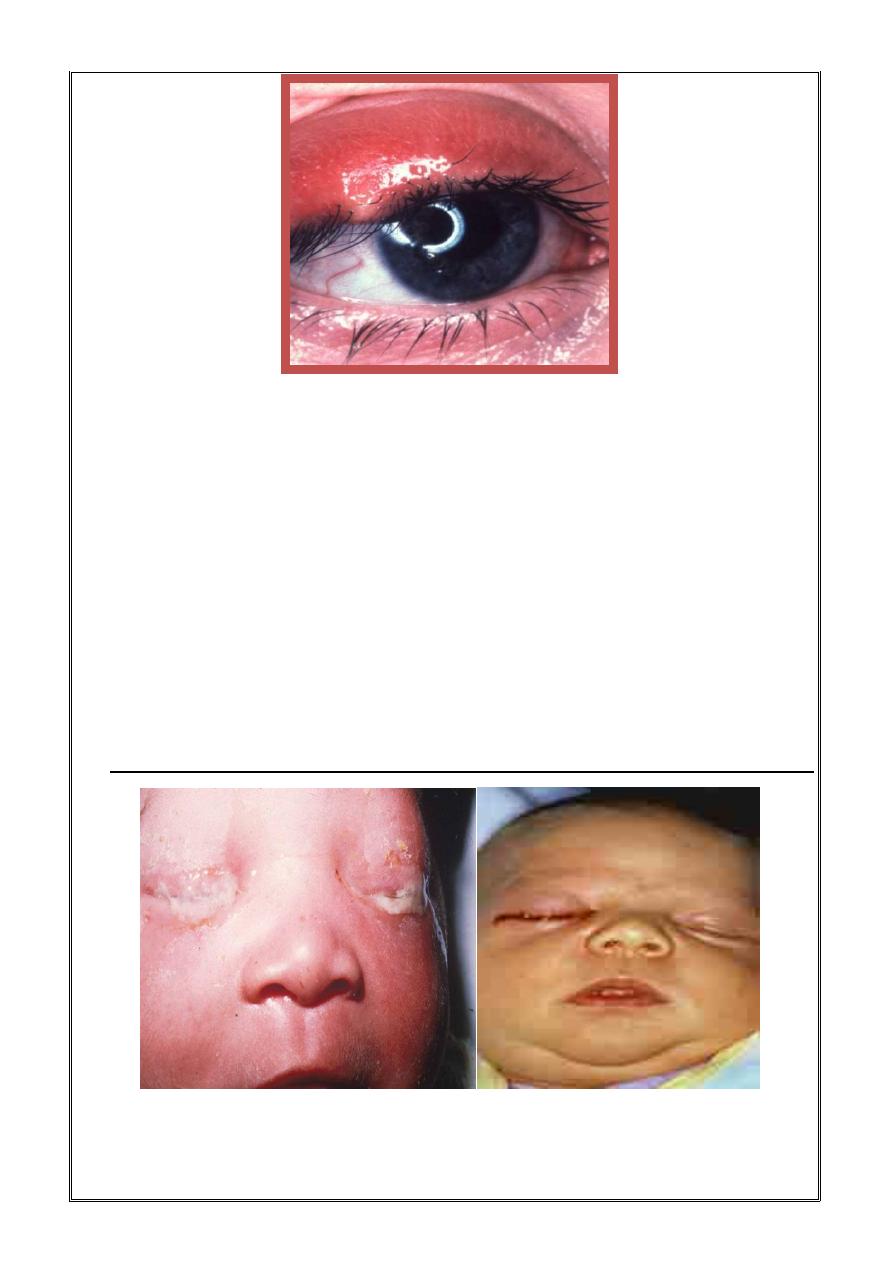
Diagnosis:
Stye : red swollening of the upper eyelid due to inflammation of eyelash
follicles.
Causes:
Bacterial infection staph. Aureus infection.
Treatment:
1) Local antibiotics & eye drops.
2) Bathing in warm water.
3) Removal of the eyelash involved.
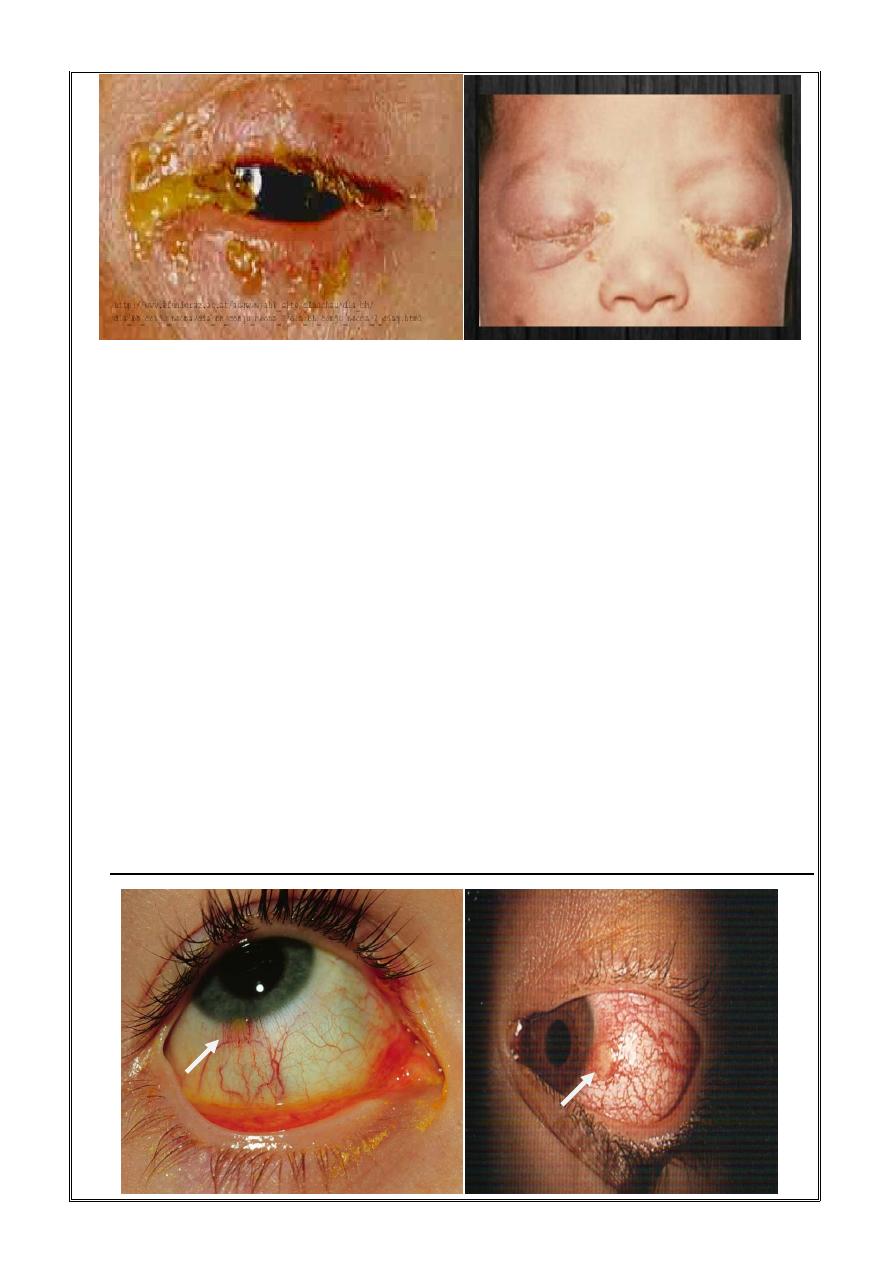
Diagnosis:
Ophthalmia neonatorum (neonatal conjunctivitis).
Causes:
1) Chemical (silver nitrate).
2) Bacterial (1
st
3 days=Staph.aureus , after the 3
rd
day=
Strept.peumonia , after the 1
st
week=Neisseria gonorrhea , after 12
days=Chlamydia).
3) after 15 days=Viral (H. influenza & herpes simplex virus).
Treatment:
1) Gonococcal infection treated by cefotaxime for 7 days.
2) Chlamydial infection by systemic erythromycin.
3) Herpes by I.V acyclovir.
4) Topical antibiotic for staph.
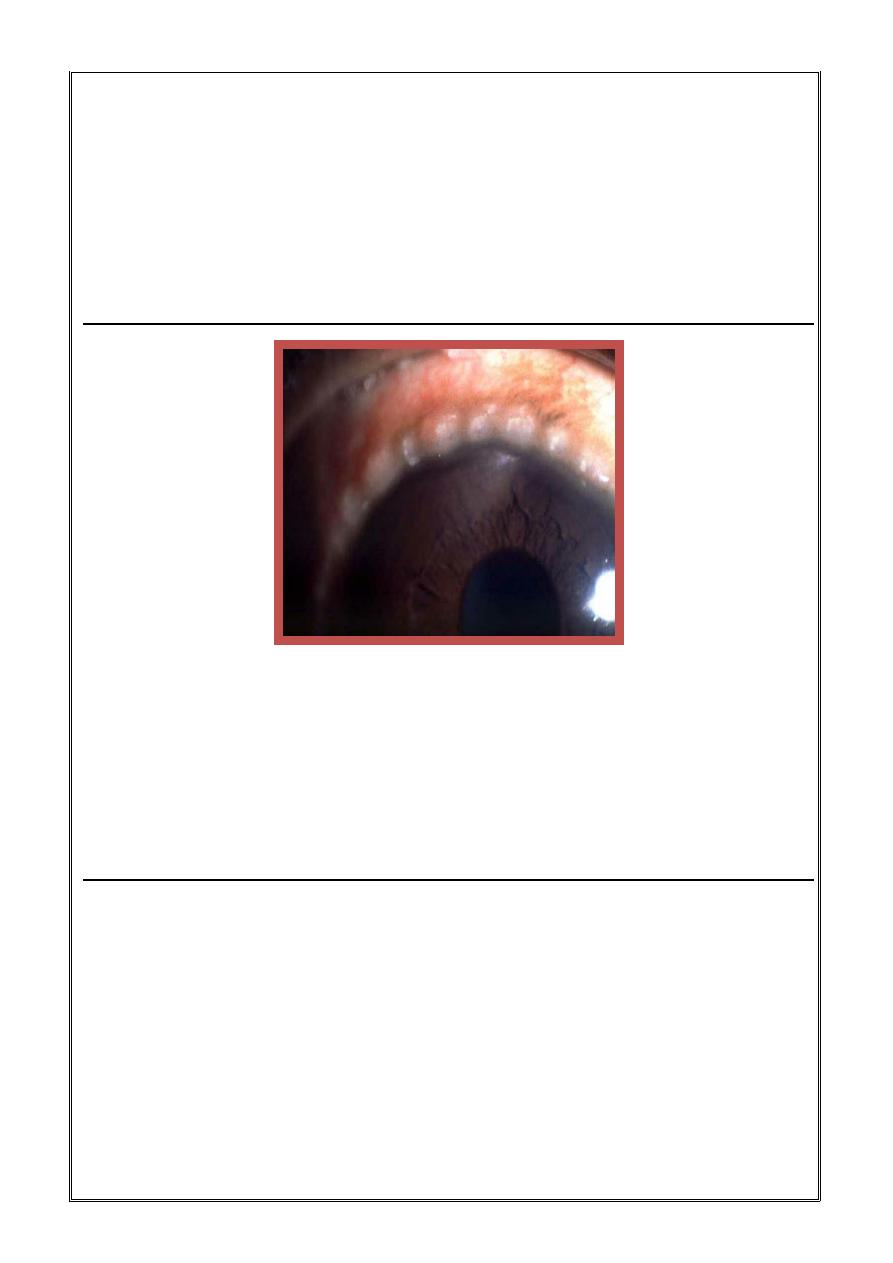
Diagnosis:
Phlyctenular conjunctivitis: Small pinkish-yellow nodule surrounded by a
zone of dilated blood vessels at corneoscleral junction.
Causes:
Hypersensitivity reaction (type 4) to endogenous antigens e.g. bacterial
antigens as T.B & Chlamydia.
Diagnosis:
Bulbar spring catarrhal:
Treatment:
Avoiding exposure to the causative allergen , topical steroids , mast cell
stabilizers, anti histaminic dark glasses & cold compresses.
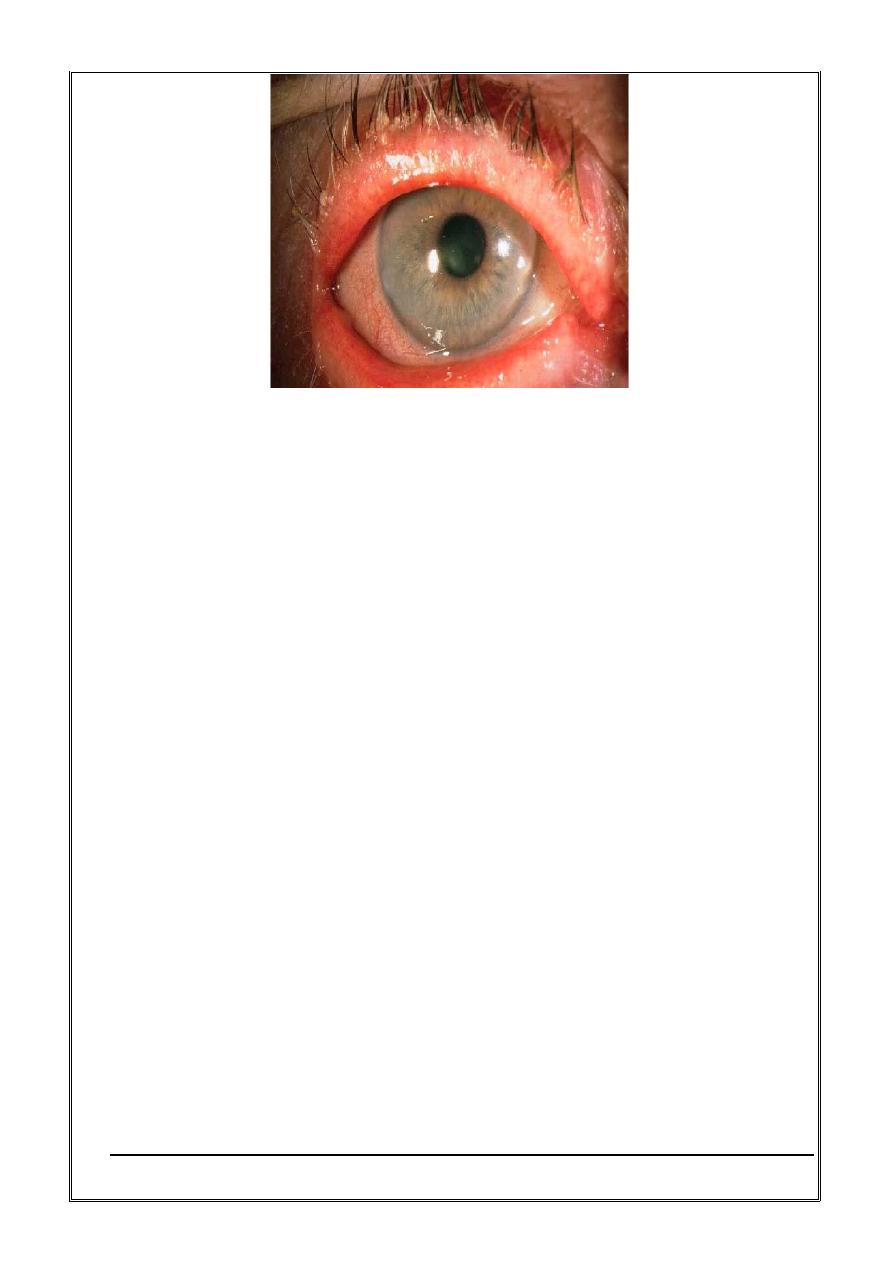
Diagnosis:
Ulcerative blepharitis: erythema & crusting of the lashes and lid margins
& adherence of the lashes with each other by oily debris.
Causes:
1) Herpes simplex & Varicella zoster dermatitis.
2) Allergic or contact dermatitis.
3) Bacterial infection (Staph.) is the usual pathogen.
4) Exposure to smoke , fumes & other irritants.
5) Sjogren syndrome may be present as blepharitis.
Complications:
Chronic conjunctivitis , Madarosis , trichiasis , Poliosis , epiphora ,
Ectropion, corneal ulcer.
Treatment:
1) Eyelid margin hygiene (warming , washing & application of
antibiotic ointment to the lid margins).
2) Antibiotic – corticosteroid solutions to reduce inflammation if the
cause is bacterial.
3) Antivirals.
4) Avoiding exposure to irritant materials.
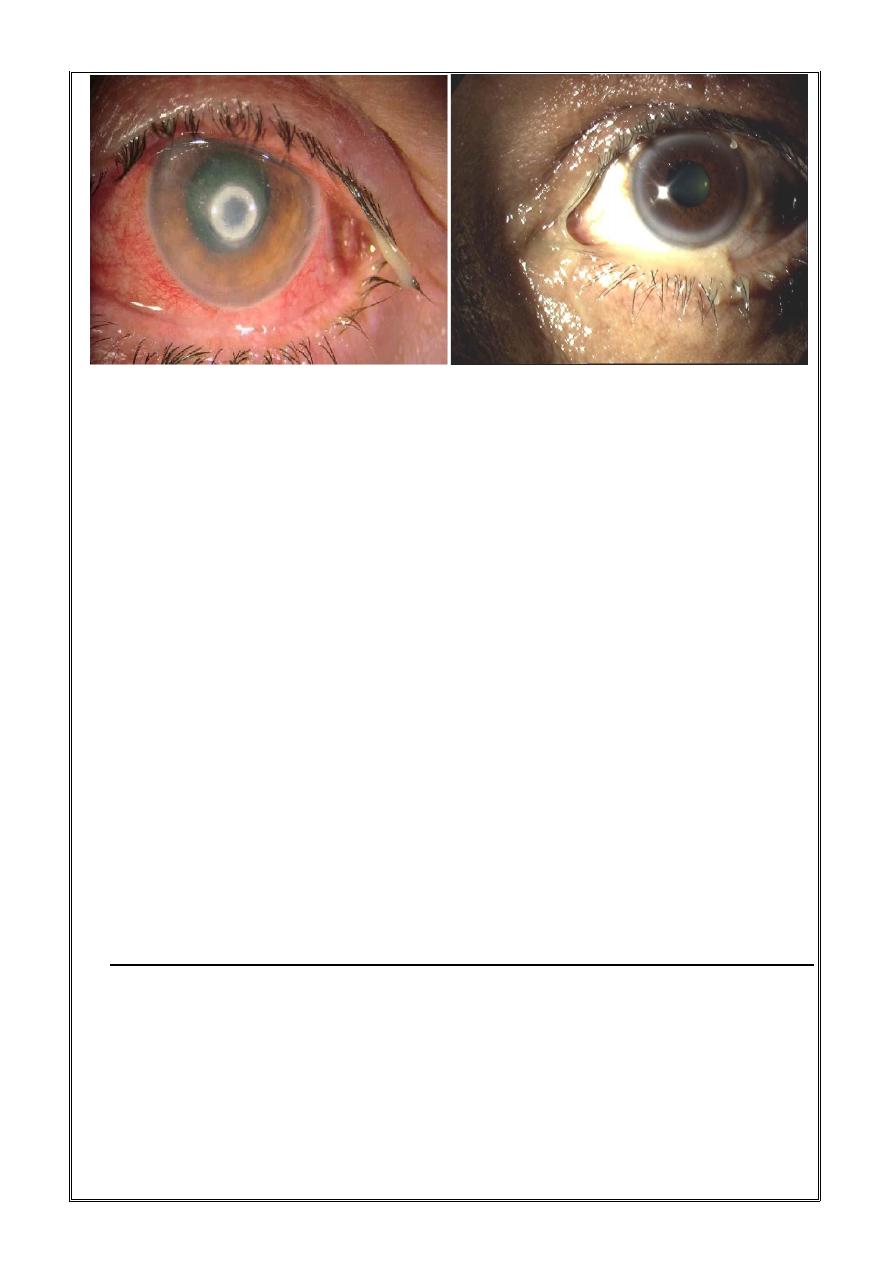
Diagnosis:
Mucopurulent conjunctivitis: Diffuse redness of the sclera with yellowish
mucopurulent discharge & eyelid edema.
Cause:
Trachoma.
Complications:
1) Membrane formation.
2) Subsequent scarring of the punctum.
3) Corneal ulcer.
Treatment:
1) Eye lotions.
2) Antibiotics ointments e.g. tobramycin at night.
3) Antibiotic eye drops (tetracycline).
4) Hot foments.
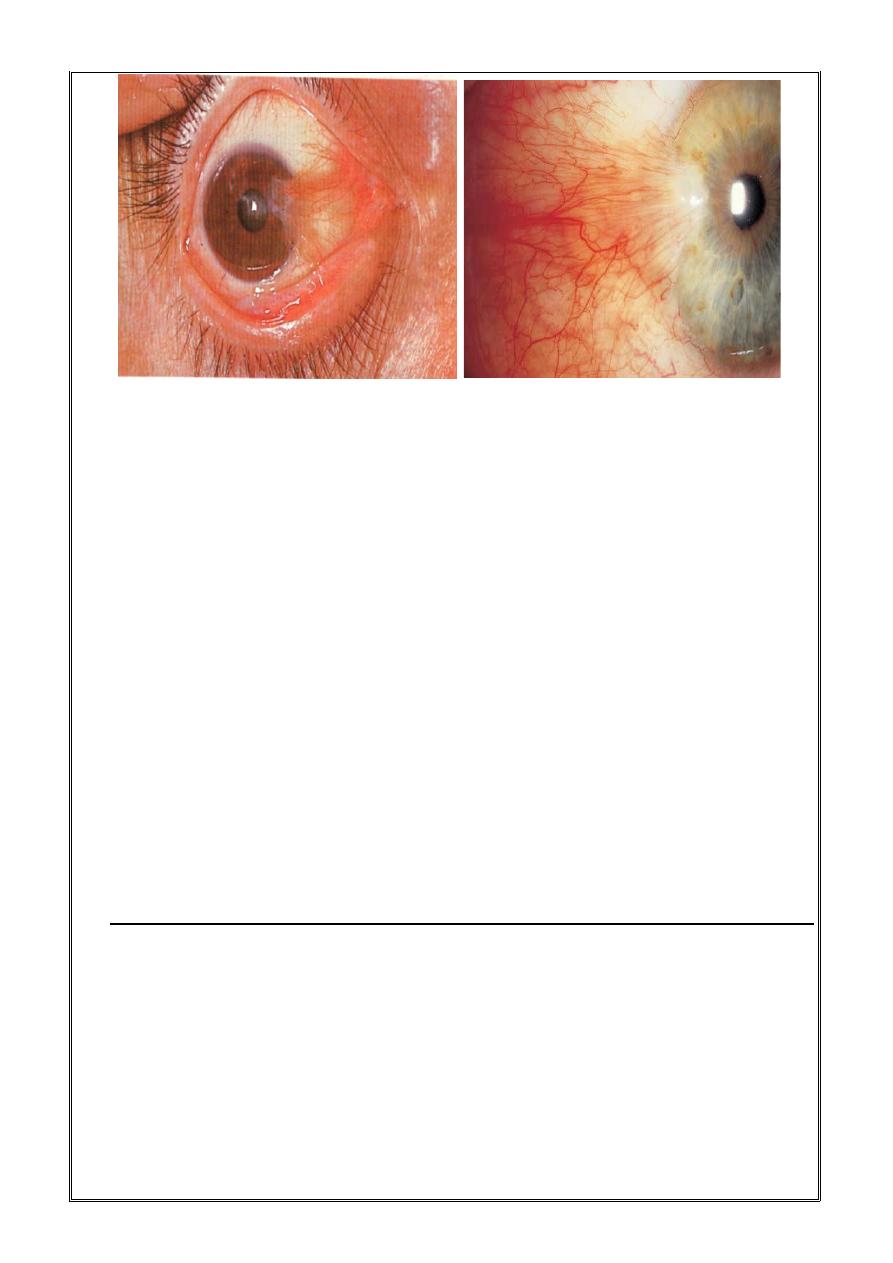
Diagnosis:
Pterygium : Localized redness located at the nasal corner of the eye ,
triangular in shape with the apex extended to involve the cornea & it is a
fibrovascular ingrowths.
Causes:
1) Direct ultra violet exposure.
2) Exposure to irritant materials (dust , smoke…).
Treatment:
Surgical removal with conjunctival graft.
Surgical indications:
1) Functional abnormalities of vision.
2) Foreign body sensation.
3) Cosmetic reasons.
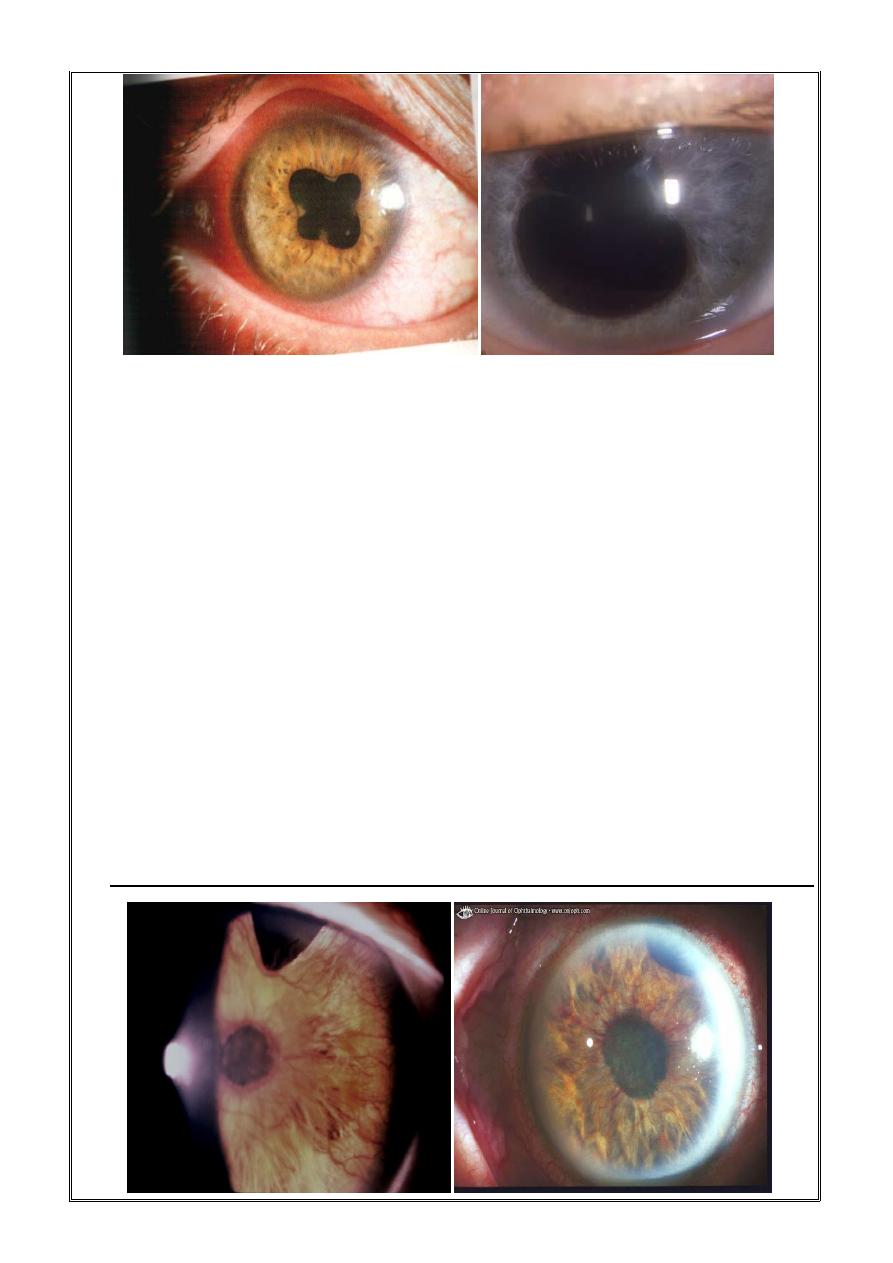
Diagnosis:
Posterior Synechiae.
Cause:
Anterior uveitis (iritis).
Complications:
1) Band keratopathy.
2) Bulus keratopathy.
3) Cataract.
4) Glaucoma.
Treatment:
1) Atropine & corticosteroid drops.
2) Surgical separation (synechialysis).
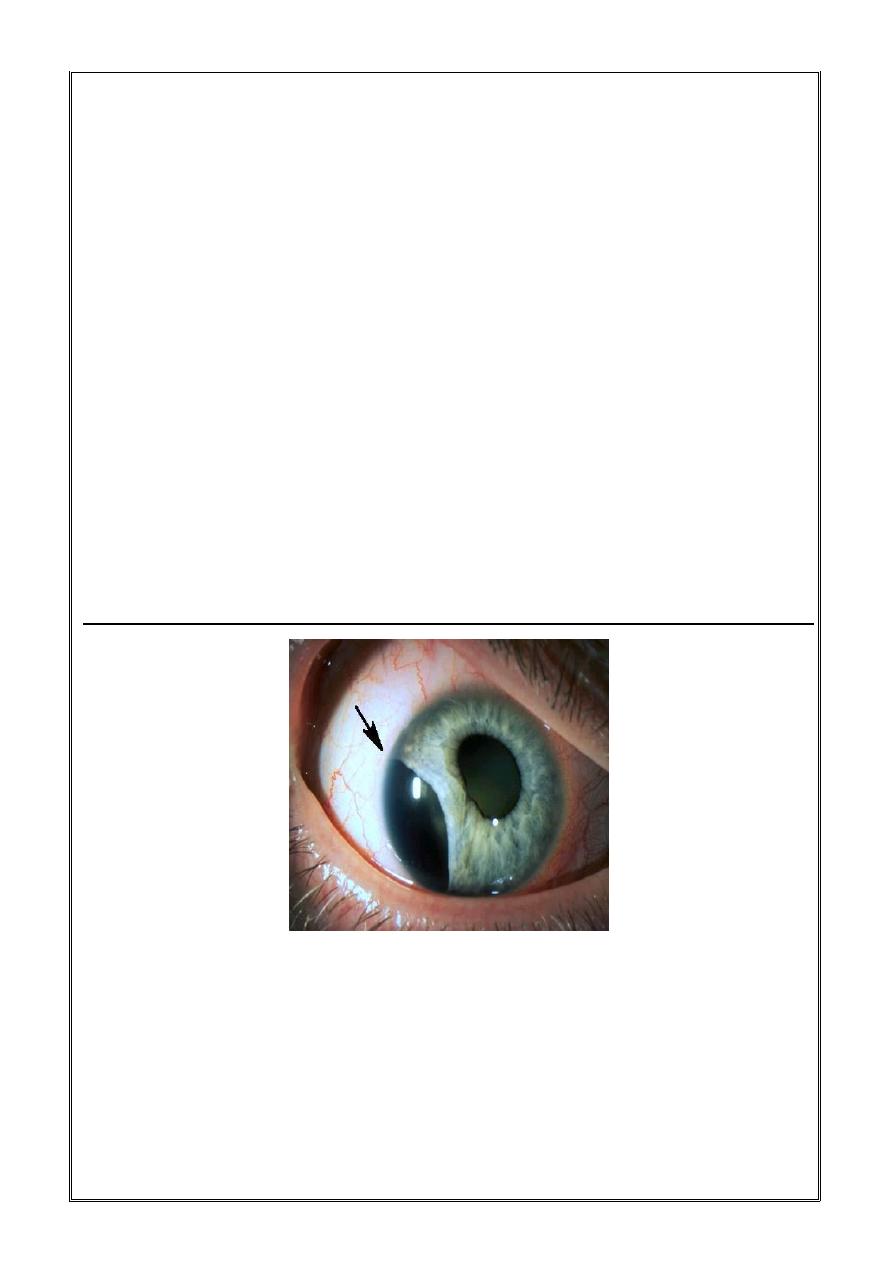
Diagnosis:
Rubeosis iridis (Growth of blood vessels onto the iris) & Peripheral
iridectomy.
Causes:
1) Diabetic retinopathy.
2) Central retinal vein occlusion(CRVO).
3) Long standing retinal detachment.
4) Ocular ischemic syndrome.
5) Hyoptonus eye.
6) Long standing uveitis.
7) Uveal melanoma.
8) Retinoblastoma.
Complication:
Rubeotic glaucoma & prognosis is very bad.
Diagnosis:
Iridodialysis: A dark crescentic gap at the edge of the iris where the tear
has occurred.
Causes
1) Trauma.
2) Tumour excision.
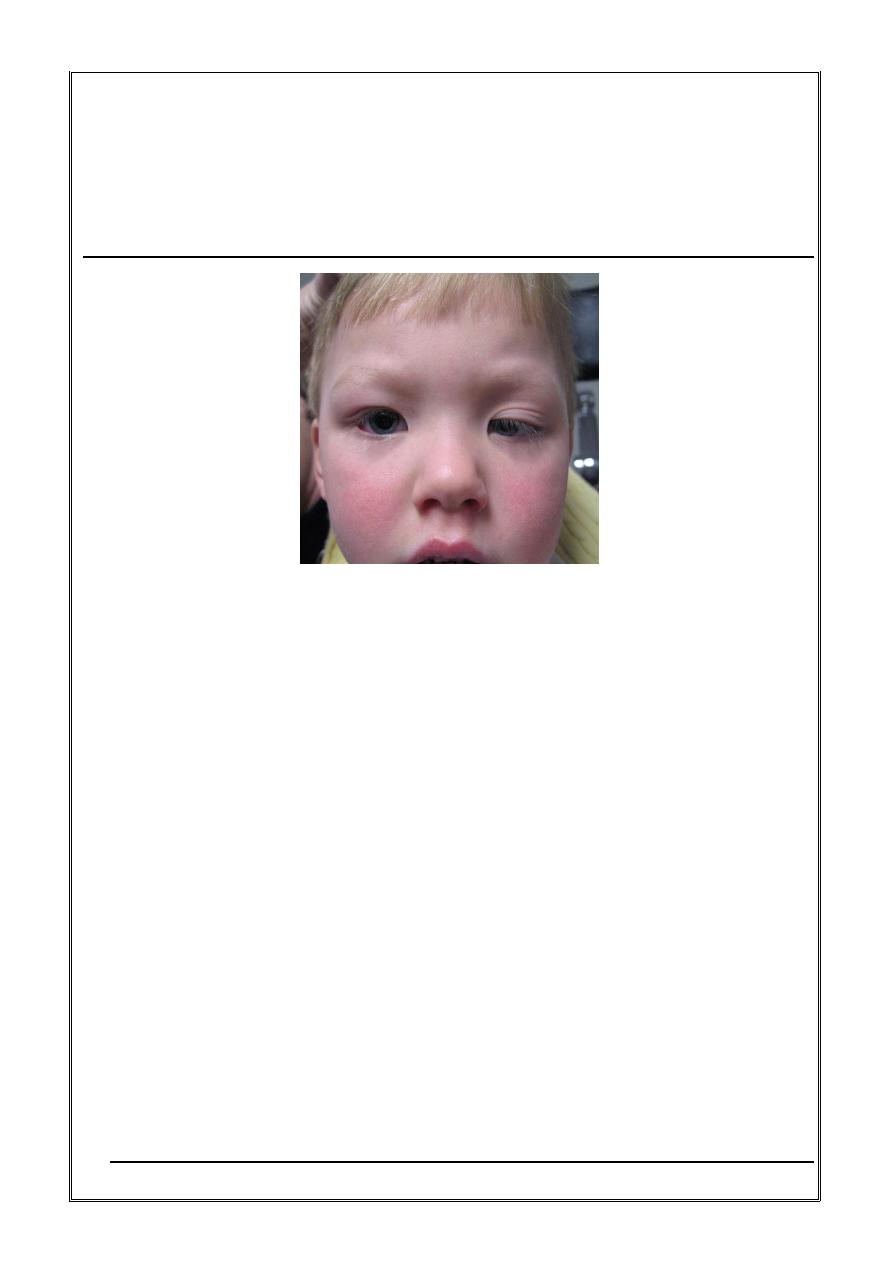
Patient complaint:
Uniocular diplopia.
Treatment:
Surgical reduction and suturing of the iris.
Diagnosis:
Left partial ptosis: drooping of the left upper eyelid.
Causes:
1) Oculomotor nerve palsy.
2) Horner syndrome.
3) Birth trauma.
4) Congenital.
Factors affecting prognosis & treatment:
1) Is the pupil covered by the ptotic lid or not?
2) Are there significant refractive errors between the eyes?
The significance is developing of ambylopia (causes):
1) Strabismus ambylopia due to squint.
2) Anisometropic ambylopia due to deferent refractive errors.
3) Deprivational ambylopia.
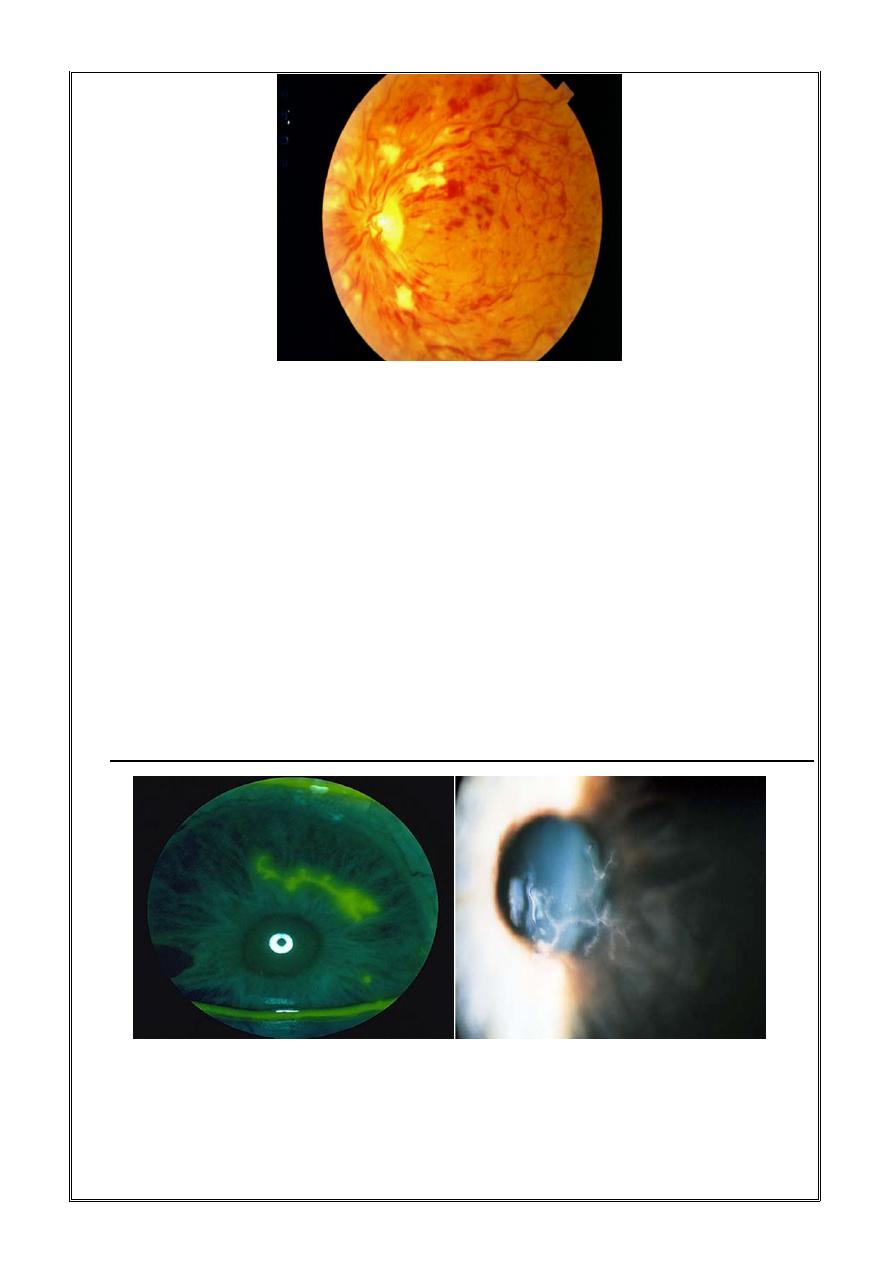
Diagnosis:
Central retinal vein occlusion(congested dilated blood vessels).
Causes:
1) Extaluminal causes: hypertension & tumour.
2) In the wall: vasculitis.
3) Intraluminal: thrombus.
Complications:
1) Neovascular glaucoma.
2) Chronic macular edema.
Diagnosis:
Dendritic ulcer.
Cause:
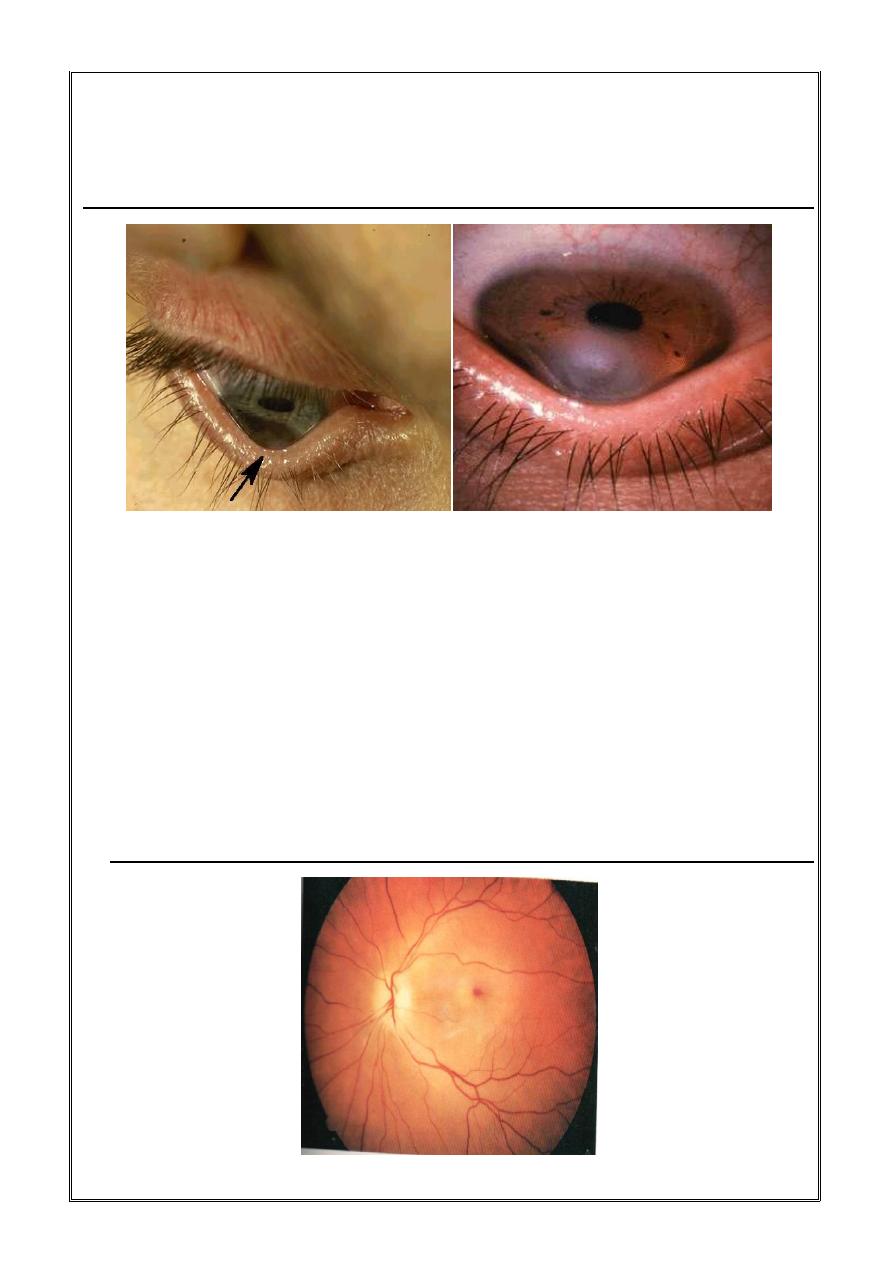
Herpes simplex virus.
Treatment:
Acyclovir , trifluridine & idoxuridine.
Diagnosis:
Keratoconus : Munson`s sign.
Significance: It is one of the common causes of reduction in visual
acuity(myopia & Astigmatism).
Treatment:
1) Rigid contact lenses.
2) Shaving the corneal surface.
3) Corneal graft.
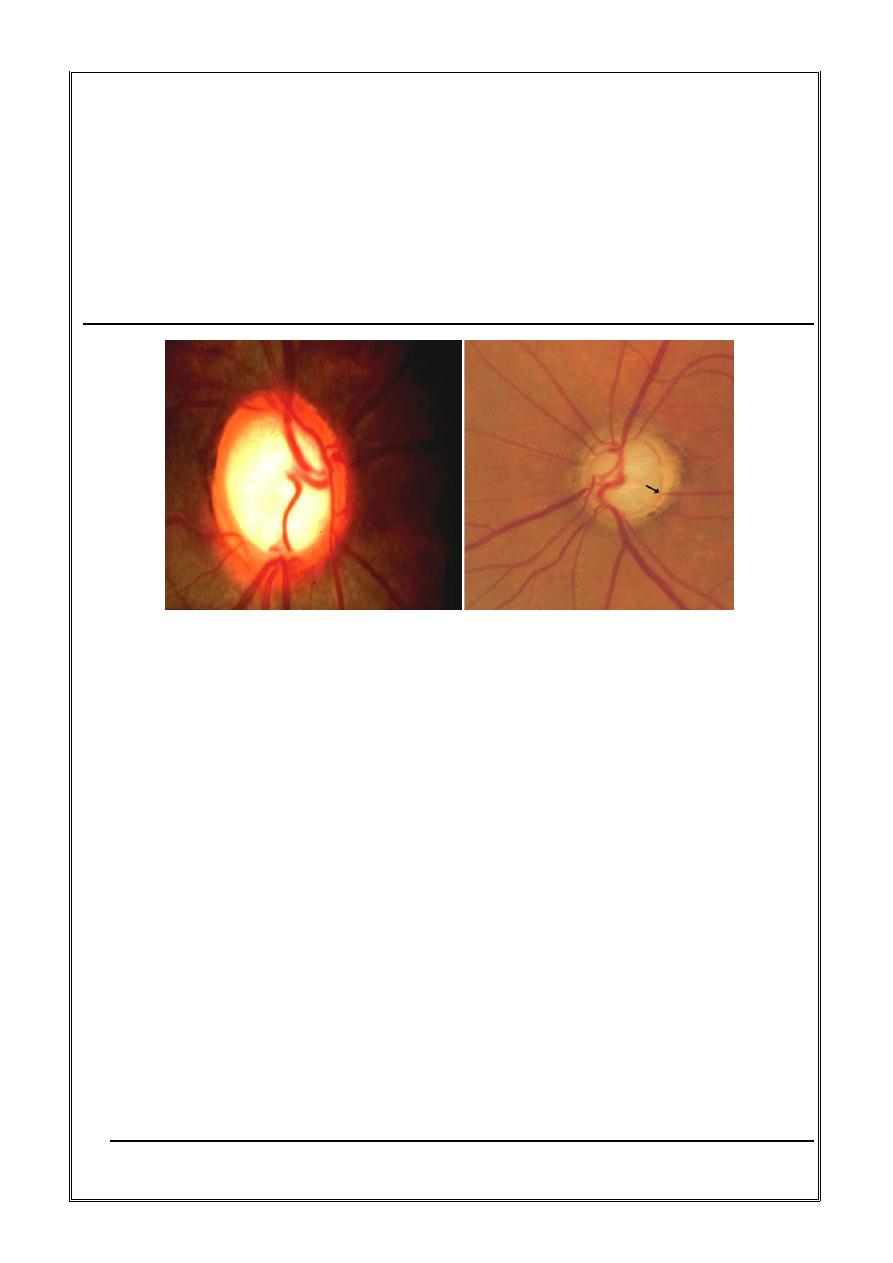
Diagnosis:
Central retinal artery occlusion:(attenuation & constriction of the
arteries – cattle track appearance) , the whole retina is pale except the
fovea (cherry red spot) due to double blood supply.
Causes:
Usually embolic.
Diagnosis:
Abnormal cupping of the optic disc(cup-disc ratio > 0.3).
Criteria for abnormal cupping of optic nerve:
1) Cup-disc ratio ≥ 0.3.
2) Progressively enlarging.
3) Asymmetrical between the two eyes.
Causes:
Primary open angle glaucoma.
Criteria to diagnose glaucoma:
1) Increased IOP. Normally 15±6 mmHg.
2) Abnormal cupping.
3) Changes in visual field.
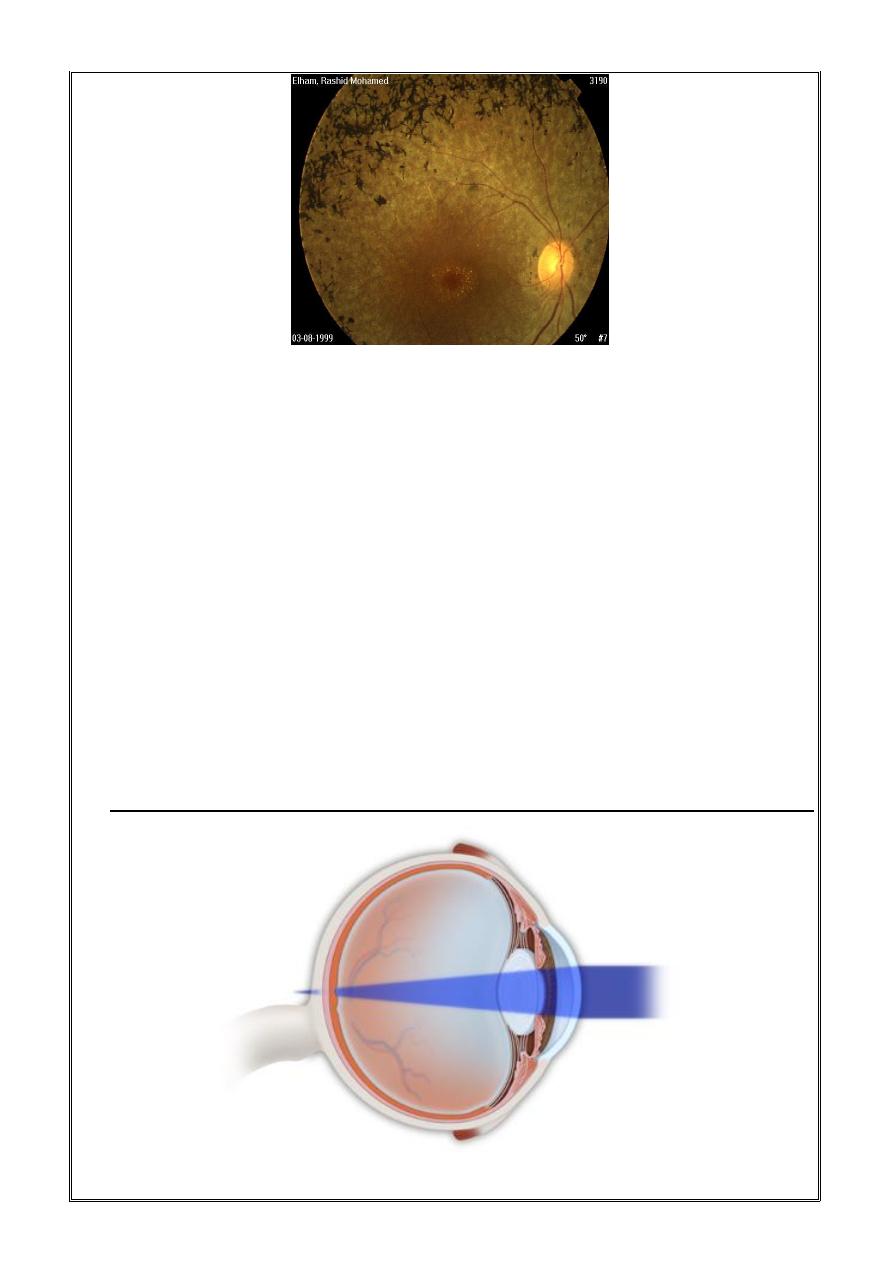
Diagnosis:
Retinitis pigmentosa: bone spicules , waxy disc & attenuated blood
vessels.
Patient complaints:
1) Night blindness(nyctalopia).
2) Visual loss.
3) Seeing flashes of light(photopsia).
Causes:
1) Autosomal dominant / recessive.
2) Bardet - biedl syndrome.
3) Refsum’s disease.
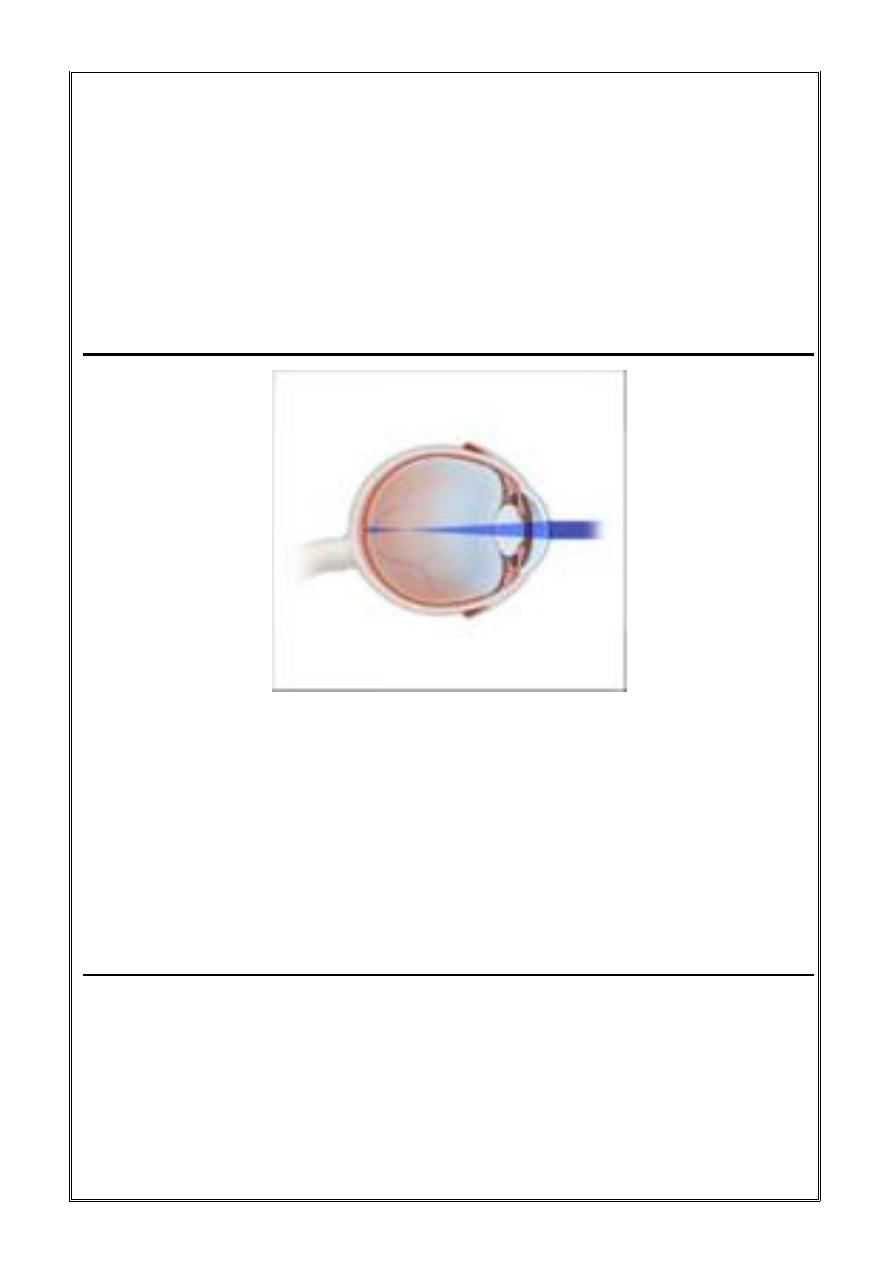
Diagnosis:
Hypermetropia.
Correction is by:
Convex lenses (+) & refractive eye surgery.
Significance:
Angle closure glaucoma as a complication.
Diagnosis:
Myopia.
Correction is by:
Concave lenses (-) & refractive eye surgery.
Retinal detachment , macular hole & open angle glaucoma as
complications.
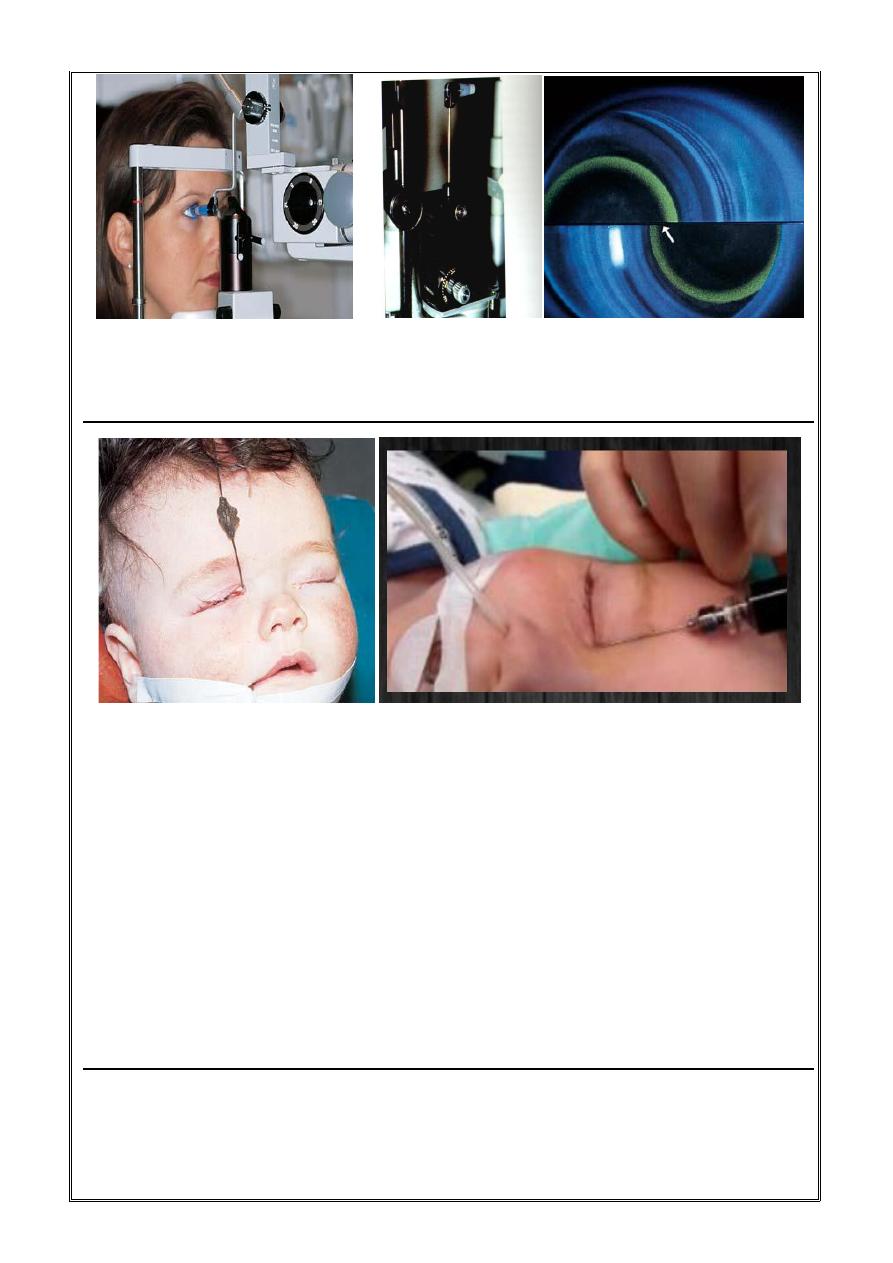
Name the device & what is it used for?
Goldmann applanation tonometer for measuring IOP.
Diagnosis:
Congenital failure of canalization of nasolacrimal duct.
Procedure\management:
1) Reassurance of the parents.
2) Topical antibiotic with massage & waiting till the end of first year.
3) If not opened , probing and irrigation with antiseptic solution.
Child presentation:
Lacrimation.
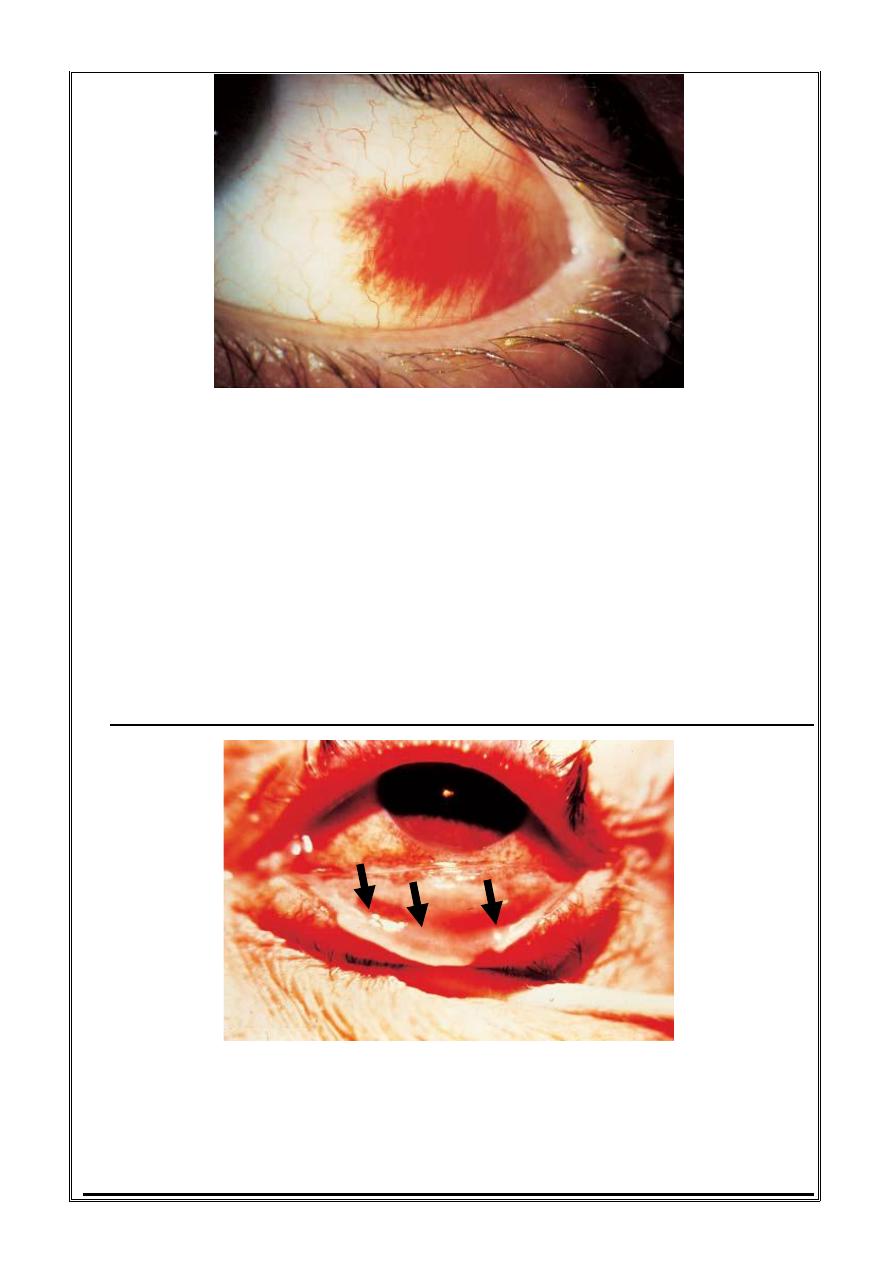
Diagnosis:
Subconjunctival hemorrhage(sectoral redness).
What do you want to ask the patient in your history taking?
1) Trauma.
2) Hypertension.
3) Straining conditions(valsalva).
4) Bleeding disorders.
5) Anticoagulants & non-steroidal anti-inflammatory drugs.
Diagnosis:
Membranous conjunctivitis.
Causes:
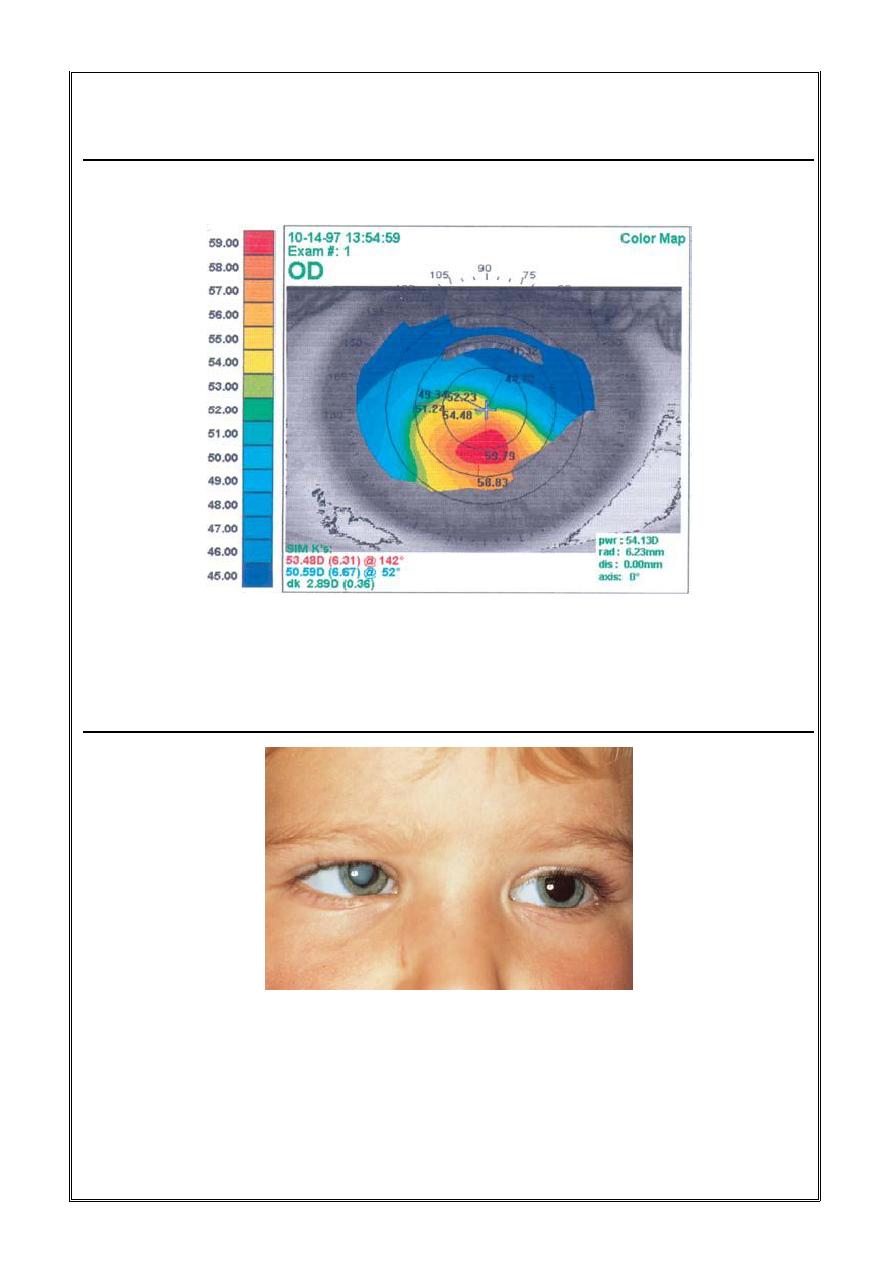
True membrane: diphtheria.
Pseudo-membrane: most of bacterial infections like staph.
Corneal topography.
Used for studying the shape & refractive power of cornea in every point
with details.
Diagnosis: Leukocoria & pseudosquint.
Causes of Leukocoria:
1) Retinoblastoma.
2) congenital cataract.
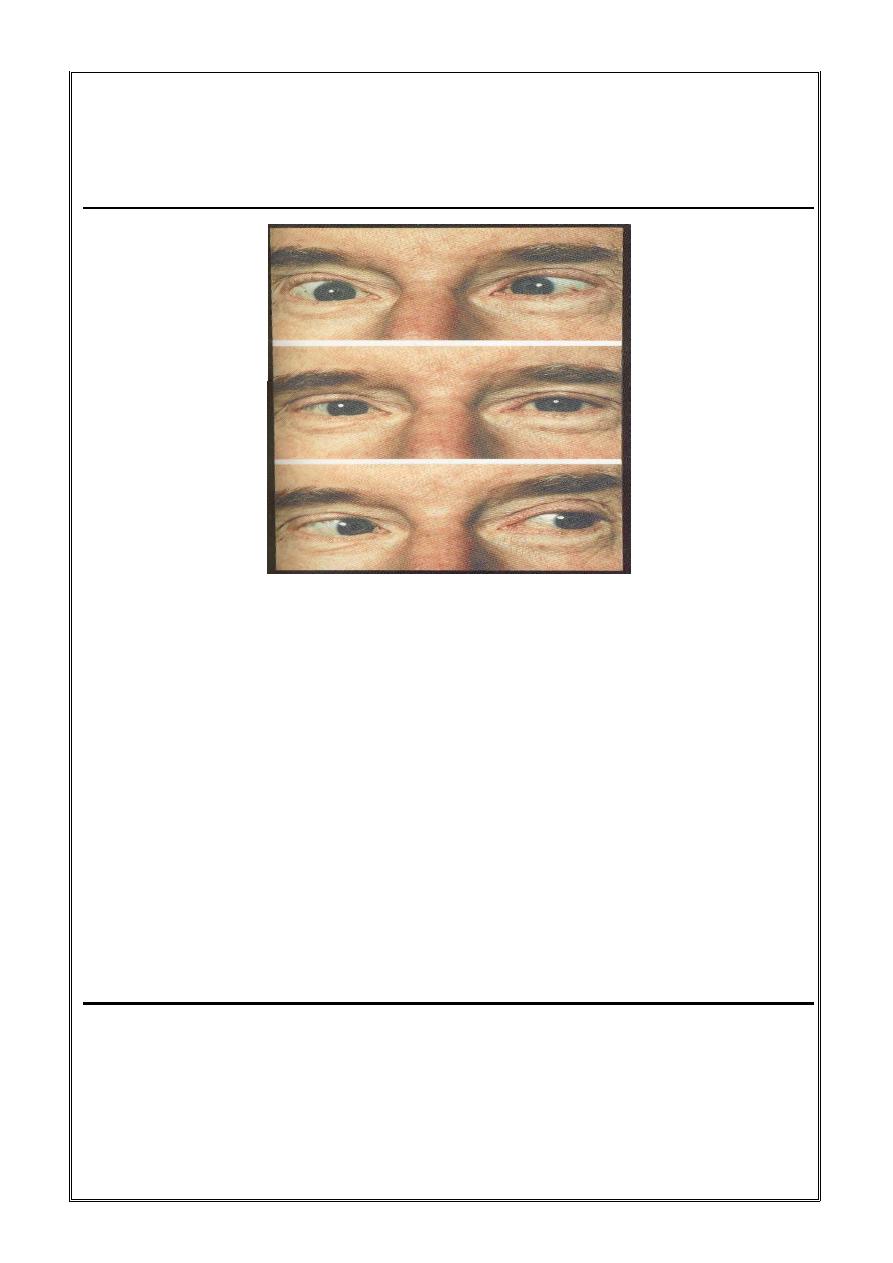
3) Retinopathy of prematurity.
Cause of pseudosquint:
Epicanthal fold.
Is it a concomitant or incomitant squint?
It is incomitant squint(being maximal in the direction of the action of the
affected muscle).
Top photo:
Patient looking to the right.
Which muscle is affected?
Right lateral rectus.
What is the nerve supply?
Right abducent nerve.
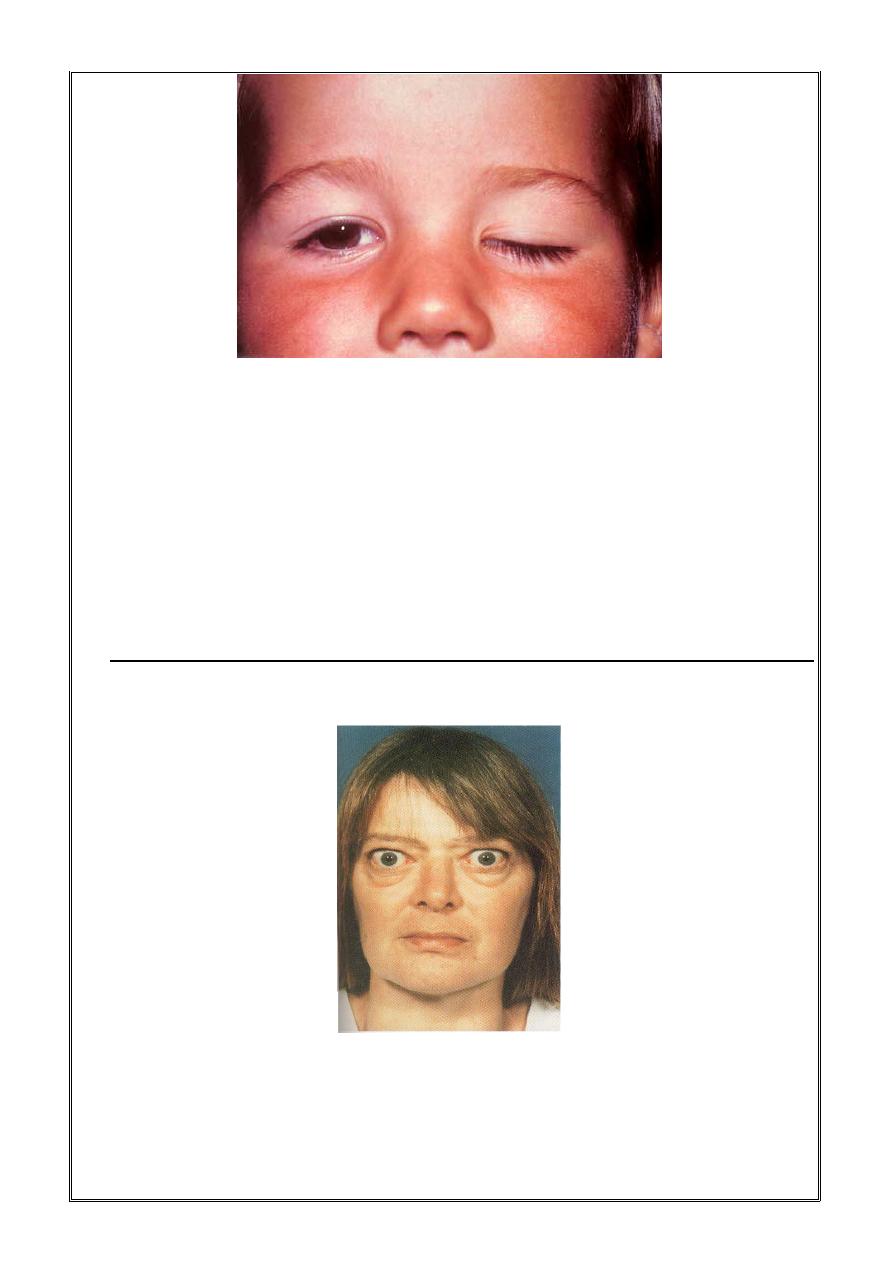
Diagnosis:
Left complete ptosis.
Causes:
1) Oculomotor nerve palsy.
2) Horner syndrome.
3) Birth trauma.
4) Congenital.
Describe this facies:
Staring facies & periorbital swelling(thyroid eye disease).
Enumerate four ocular features of this disease:
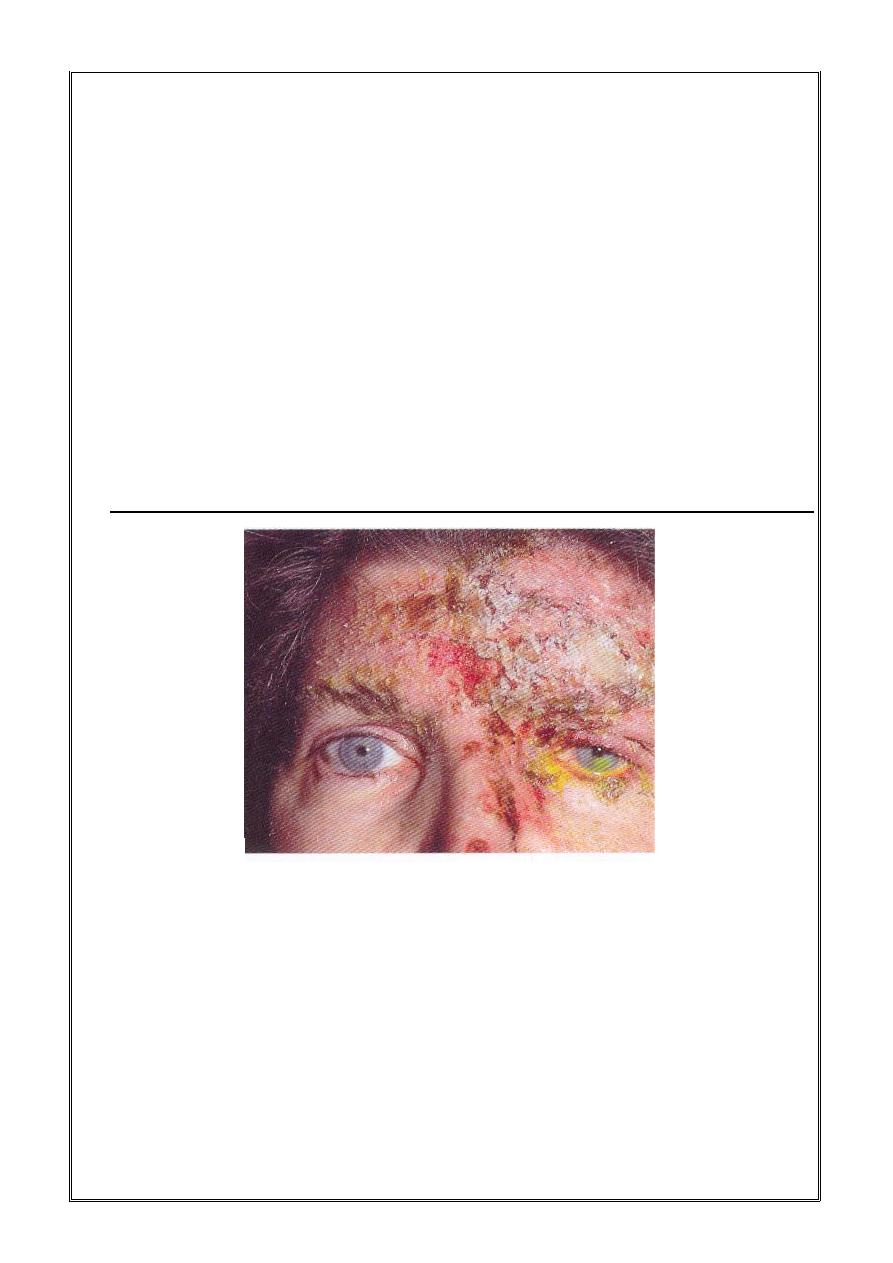
1) Lid lag.
2) Lid retraction.
3) Exophthalmoses.
4) Chemosis.
5) Periorbital soft tissue changes as chemosis & lid swelling.
6) Exposure keratopathy.
7) Ophthalmoplegia.
Enumerate four systemic features of this disease:
1) Tachycardia.
2) Tremor.
3) Increased appetite with loss of weight.
4) Goitre.
Description of skin lesion:
Crusty lesion on erythematous base involving the left forehead & the
nose.
Describe the ocular lesion:
Yellow discharge(fluorescenein stain): corneal ulcer.
Diagnosis:
Herpes zoster ophthalmicus
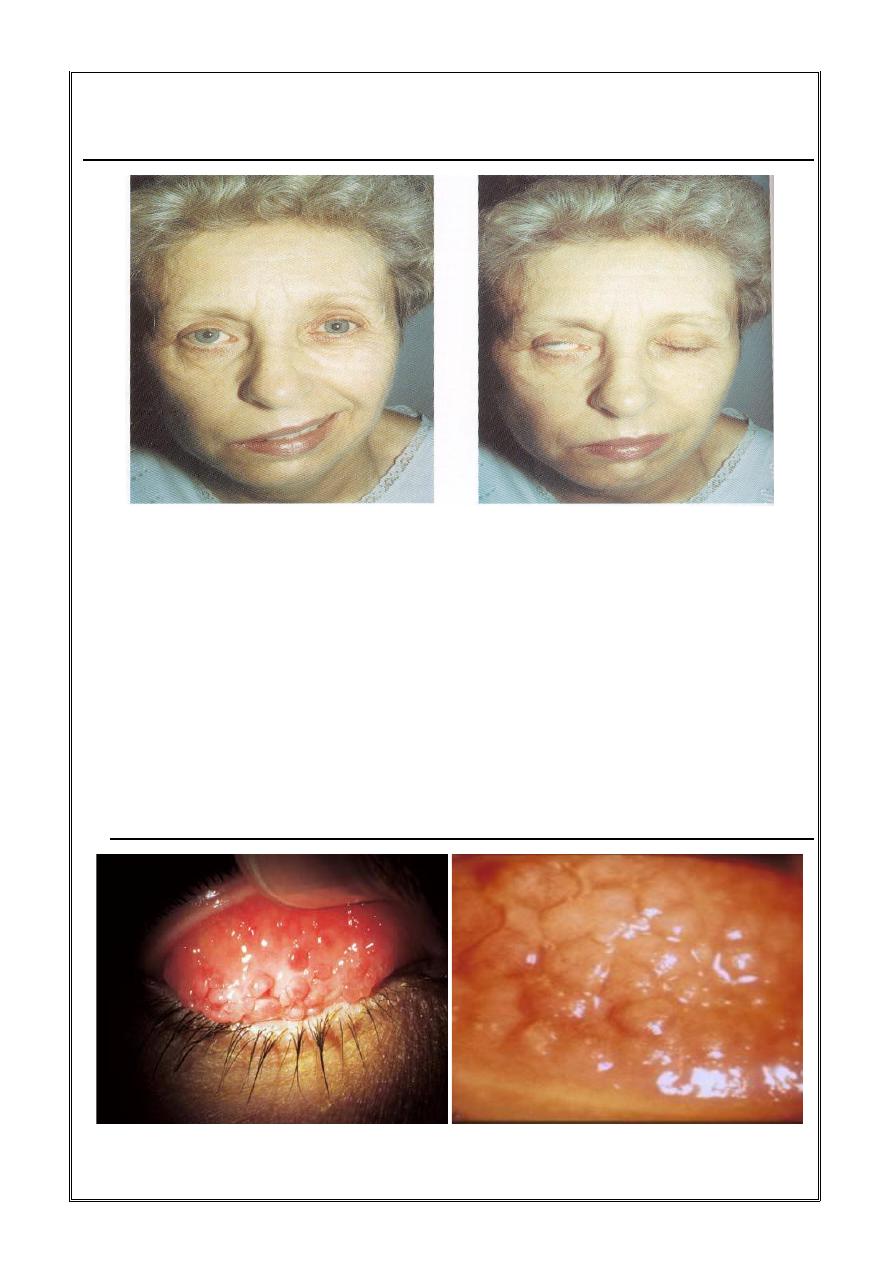
Casue:
Herpes zoster(varicella zoster virus).
Diagnosis:
Right lower motor facial palsy with lagophalmus & Bull's phenomenon.
Significance:
Exposure keratopathy.
Treatment:
1) Artificial tear drops.
2) Surgery (Lid shorting procedure: lateral tarsorrhaphy).
Diagnosis:
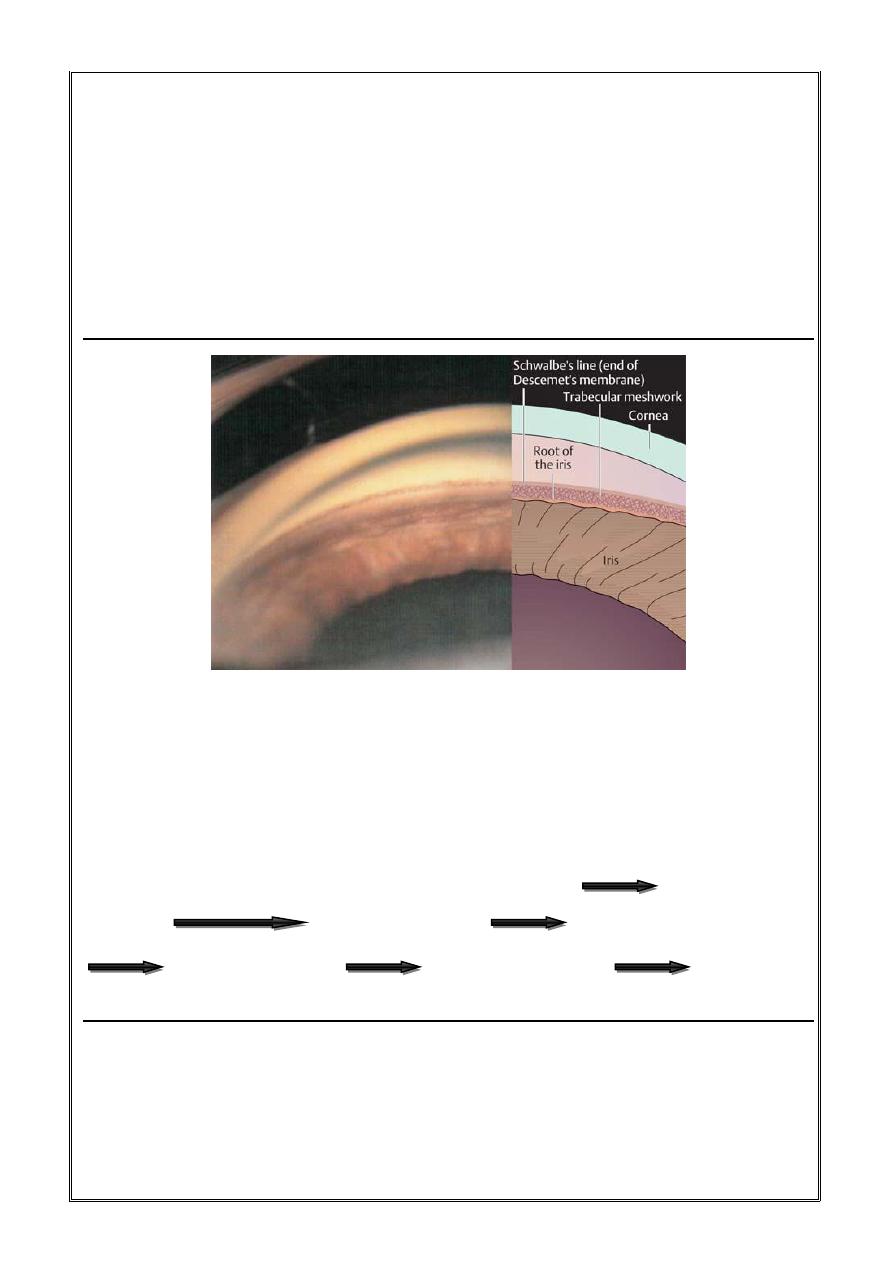
Papillae of right upper eyelid(gobble stone appearance).
Causes:
Allergic conjunctivitis: atopic , seasonal , giant papillary conjunctivitis.
Treatment:
Avoiding exposure to the causative allergen , topical steroids , mast cell
stabilizers, anti histaminic , dark glasses & cold compresses.
By using which test we can get this view?
Viewing the angle of anterior chamber by using gonioscope with
goniolens for detecting glaucoma.
Describe the aqueous circulation:
It is produced by the ciliary process of ciliary body posterior
chamber
through pupil
anterior chamber trabecular meshwork
Canal of Schlemm collecting channels episcleral
venous plexus.
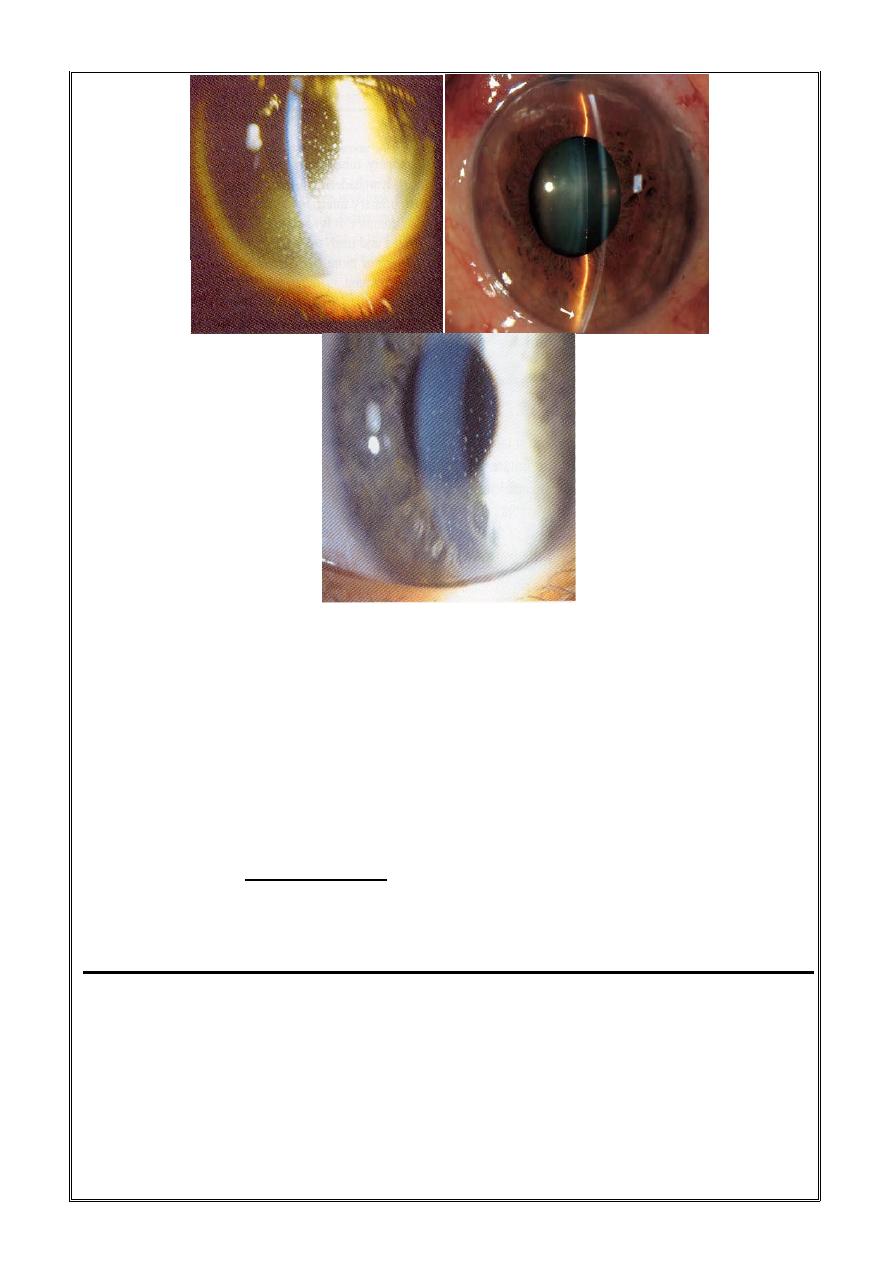
Comment on the anterior chamber depth:
1) Eclipse sign: we shine a light on the temporal aspect of the patient
anterior chamber & watching the iris , if the AC is deep the whole
iris is illuminated , if the AC is shallow , only the temporal part is
illuminated.
2) Important in angle closure glaucoma.
If this patient is asymptomatic, how would you treat him?
Miotic agents , alpha agonist , carbonic anhydrase inhibitors and
prostaglandin analogs.
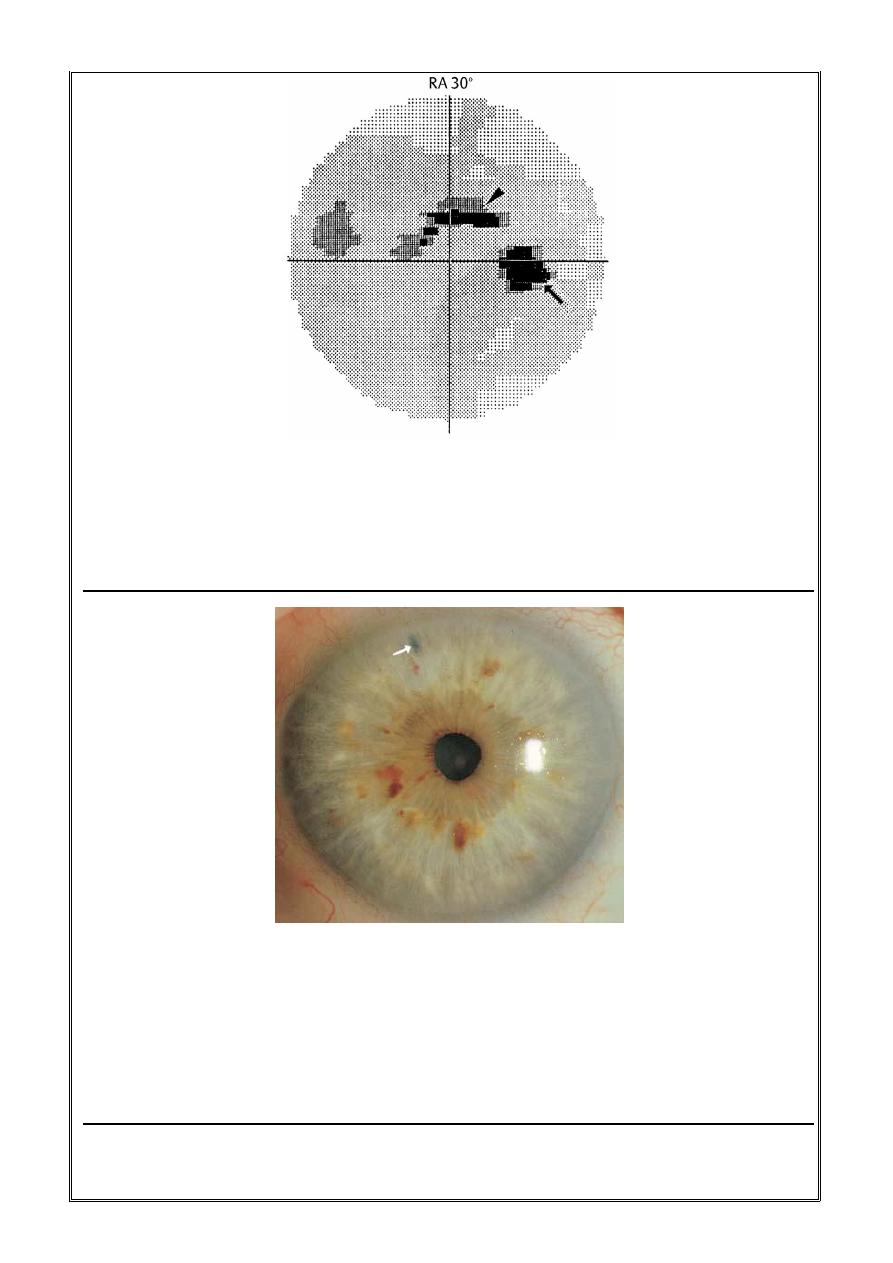
What is this & give diagnosis?
Perimetry graph showing paracentral scotoma in open angle glaucoma.
Patient complaint: no complaint , it is diagnosed by chance.
What is this?
Laser Iridotomy.
Indication:
Shallow anterior chamber(angle closure glaucoma).
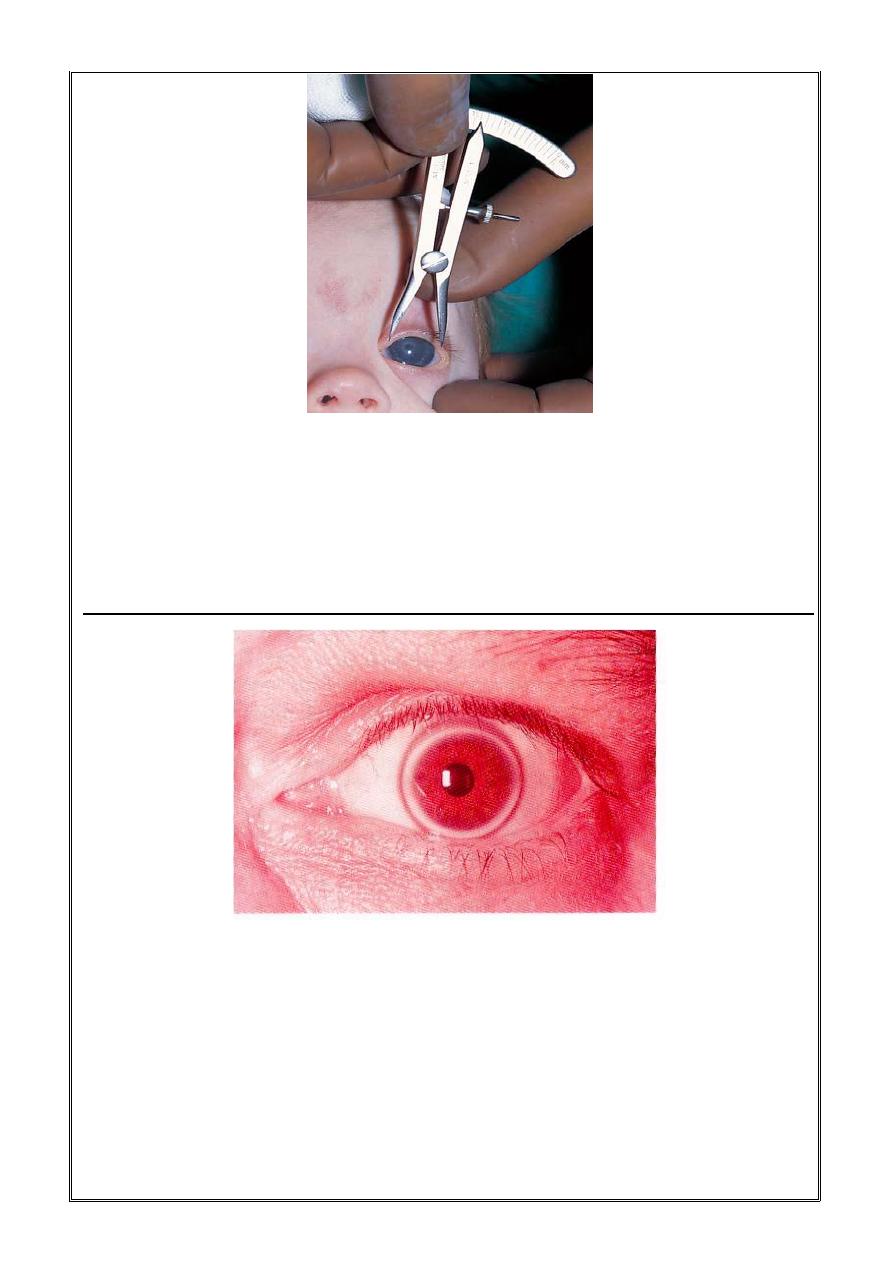
What is he doing?!
Measuring corneal diameter by a caliber.
Why?
To detect & follow up the congenital glaucoma ( buphthalmos).
What is this lesion?
Arcus lipidis.
What is the clinical significance?
It indicates hyper lipidemia in young people.
What is the visual prognosis?
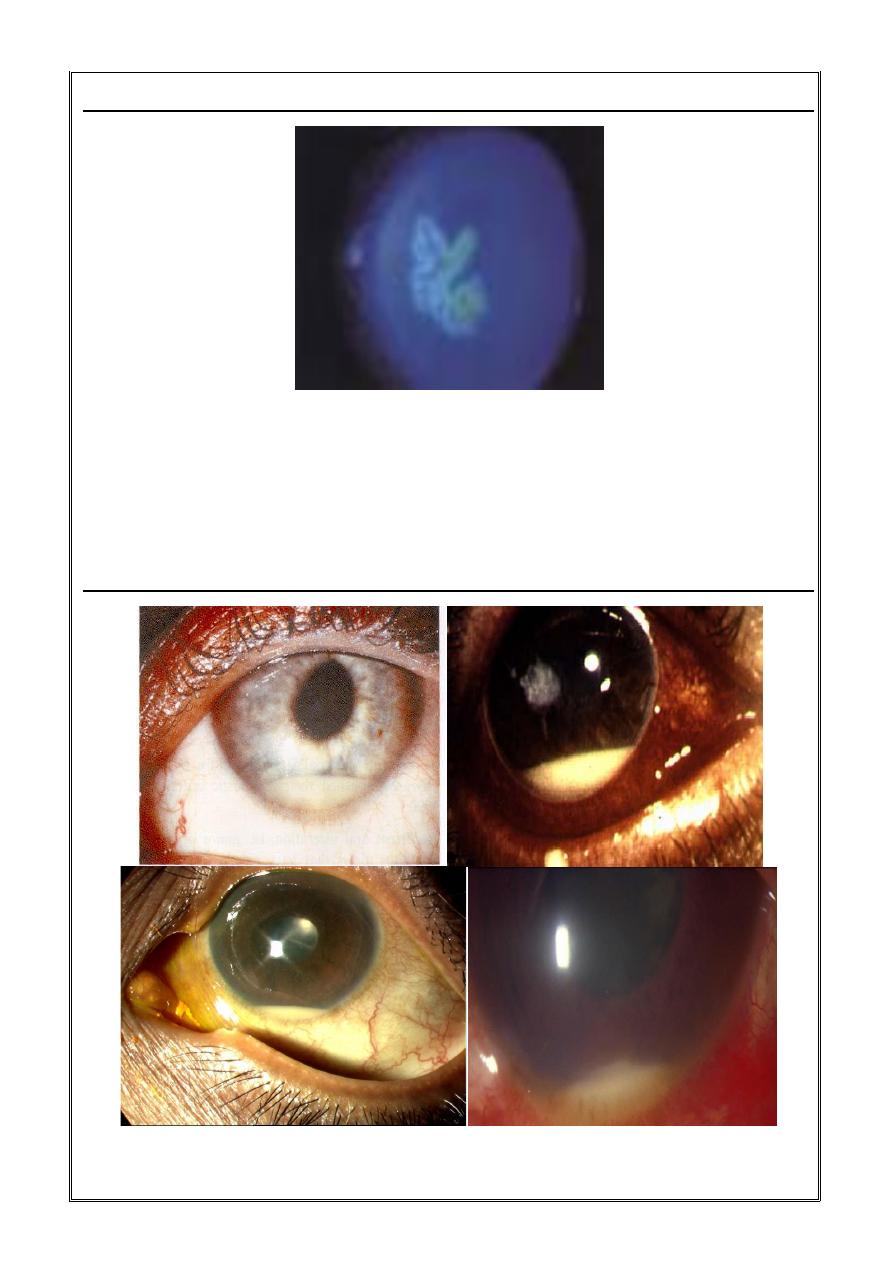
It never affect vision.
Diagnosis:
Ameboid ulcer.
Causes:
Mistreatment of dendritic ulcer by steroid.
Diagnosis:
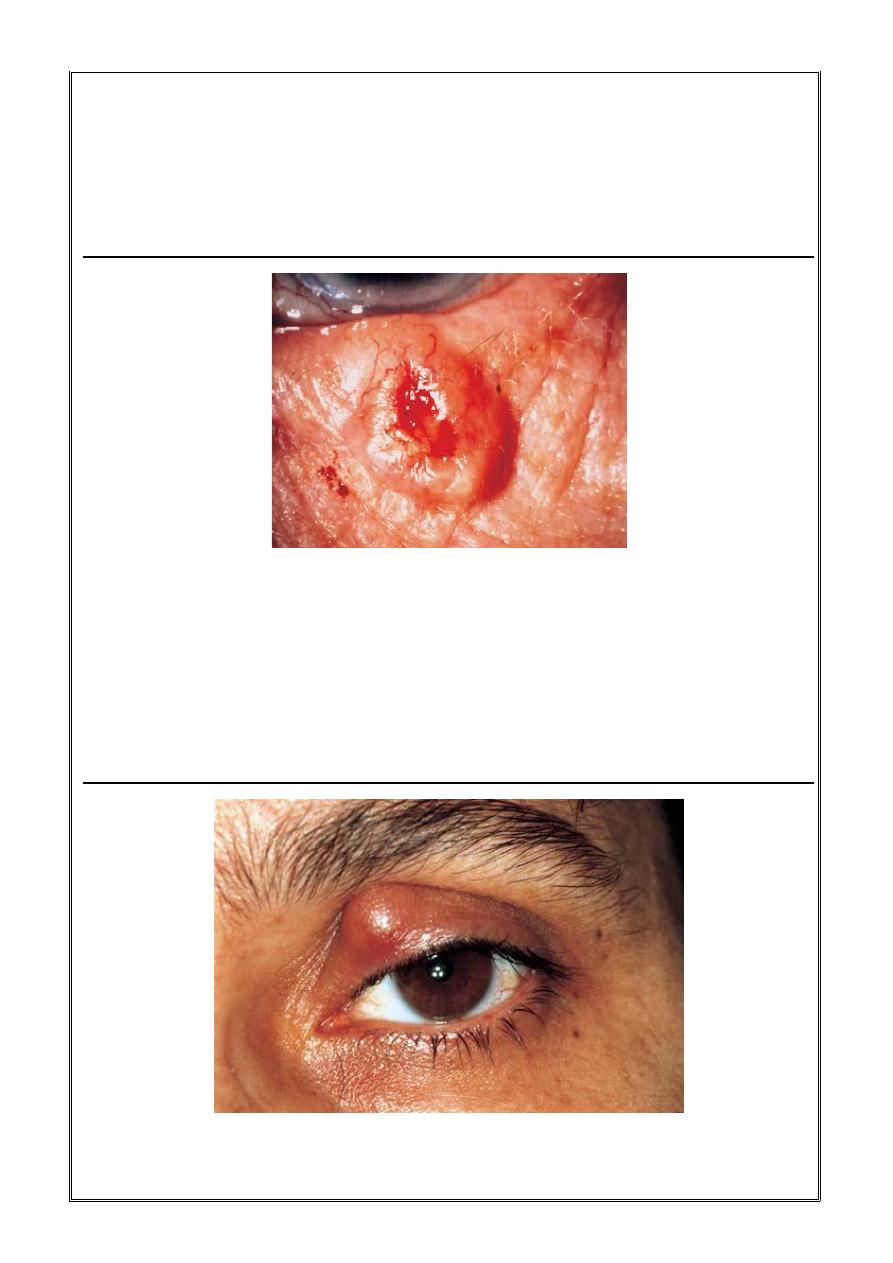
Hypopyon: pus in the anterior chamber.
Causes:
Infected: endophthalmitis(pneumococcus).
Sterile: severe iritis.
Description:
Nodulo-ulcerative lesion.
DDx:
Squamous cell carcinoma , malignant melanoma & sebaceous cell
carcinoma.
Describe this lesion:
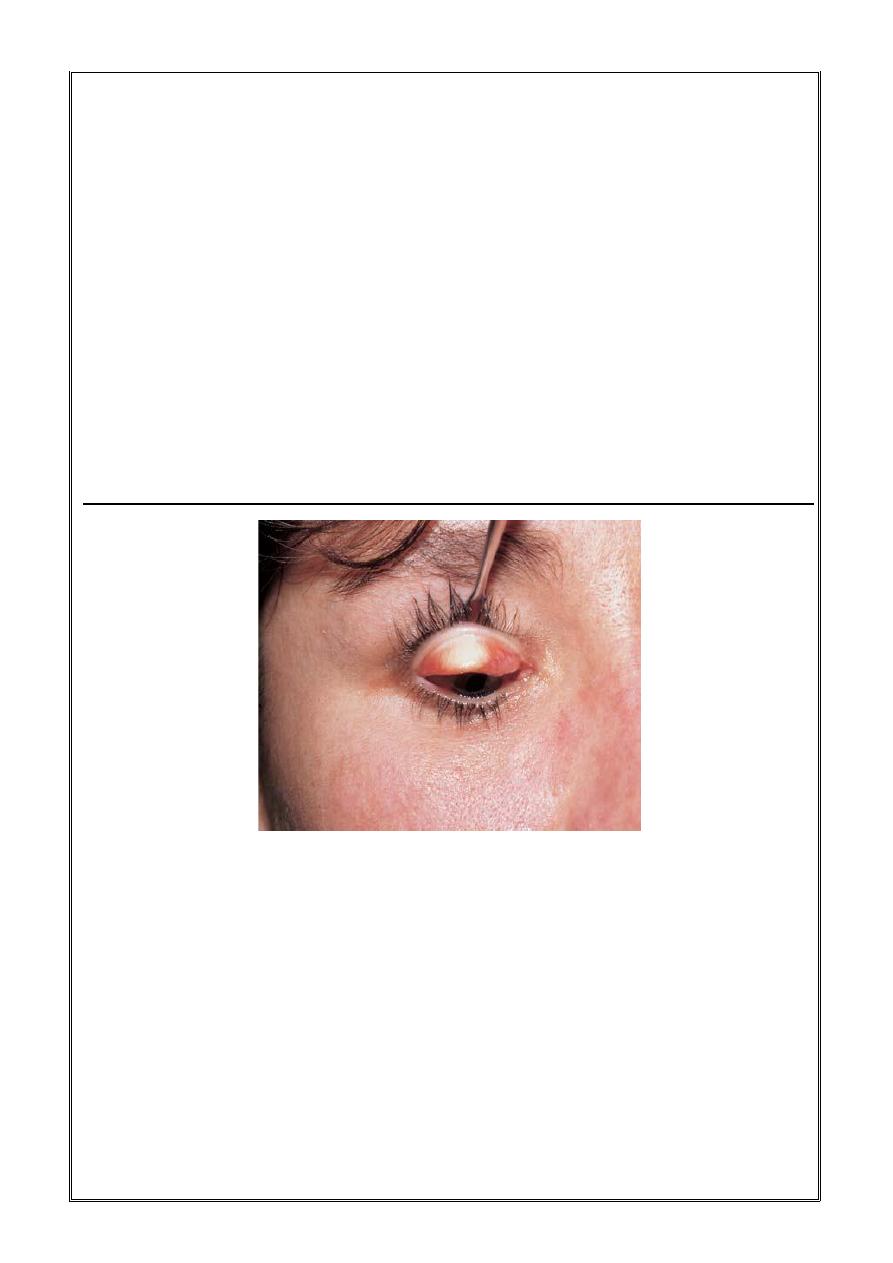
Localized swelling in the left upper eyelid.
What is the most likely diagnosis?
Chalazion.
Enumerate four possible causes:
1) blockage of tarsal glands.
2) Seborrhea.
3) Chronic blepharitis.
4) Acne rosacea.
Treatment:
Antibiotic ointment or surgical incision and curettage of the gland.
What is this procedure?
Eversion of upper eyelid.
What are its benefits?
1) Entrapment of foreign body.
2) Arlet line of trachoma.
3) Giant papillary conjunctivitis.
4) Follicular reaction.
5) Adrenochrome deposits.
6) Melanoma.
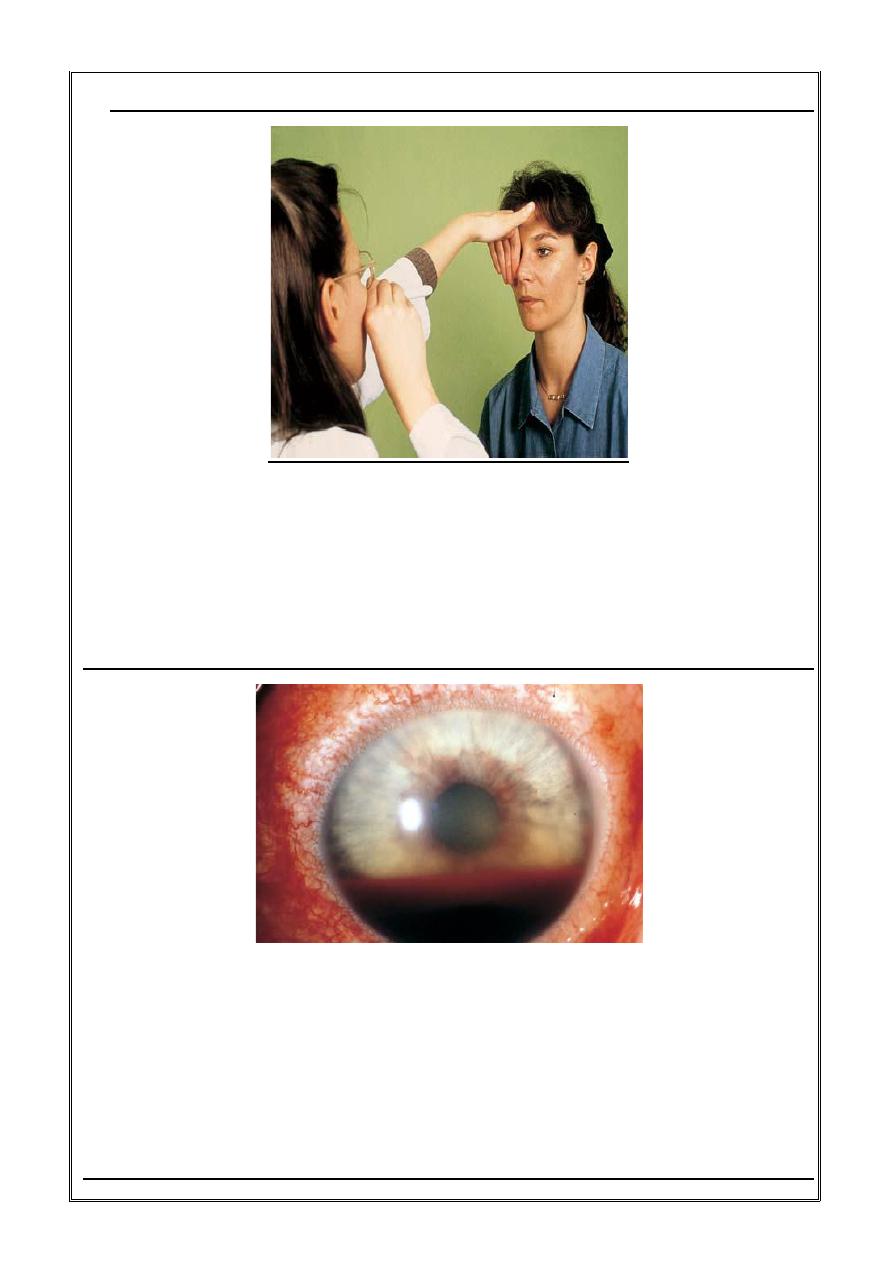
7) Conjunctival concretion.
What is this procedure?
Cover / uncover test.
In which disease you want to use it in your examination?
It is used to diagnose inapparent squint(phoria).
Diagnosis:
Hyphema.
Cause:
Trauma is the major cause , surgery (during & after) , intraocular
tumours anticoagulant treatment.
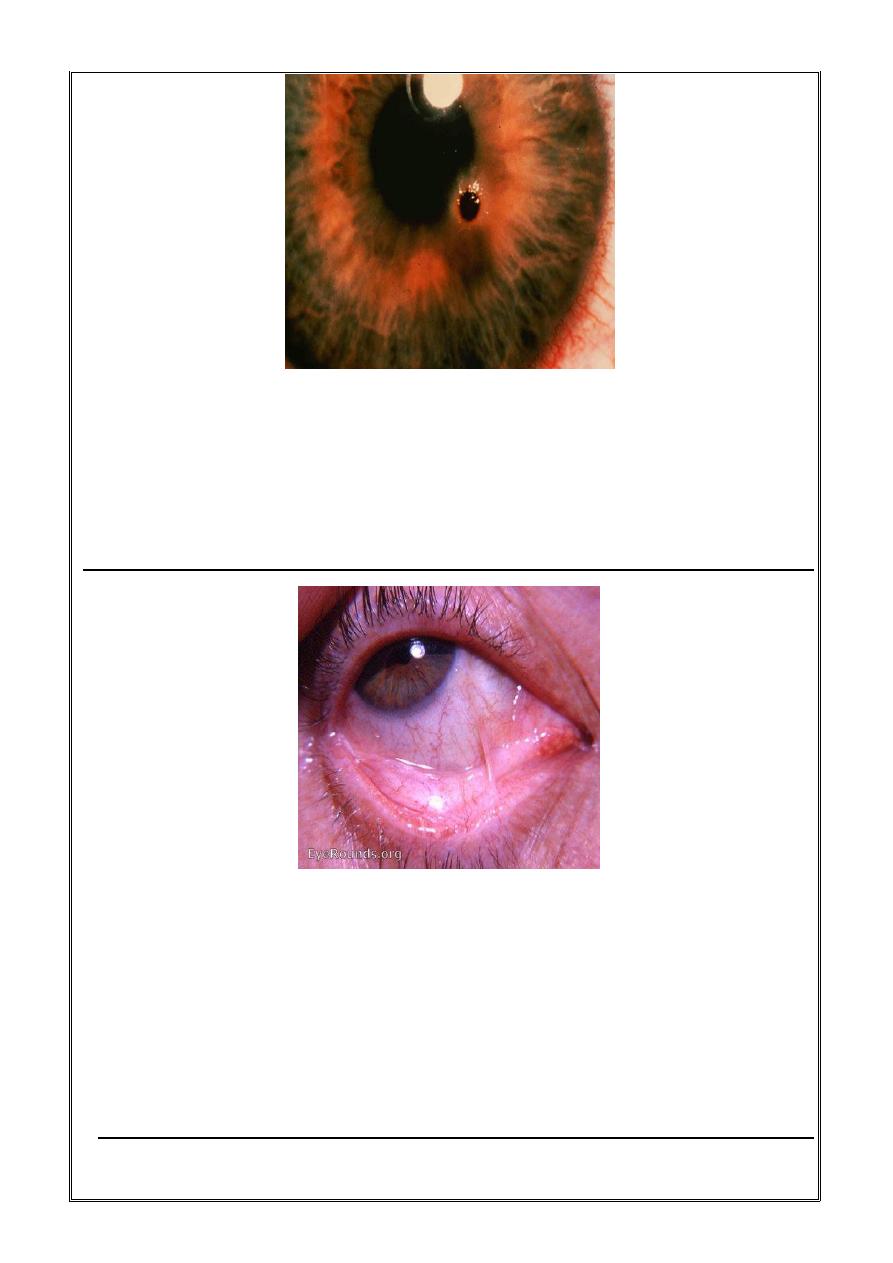
Diagnosis:
Corneal foreign body.
Treatment:
Surgical removal.
Diagnosis:
Symblepharon
Causes:
1) Post-trachomatous.
2) Post-operative ( Pterygium excision).
3) Ocular cicatricial pemphigoid.
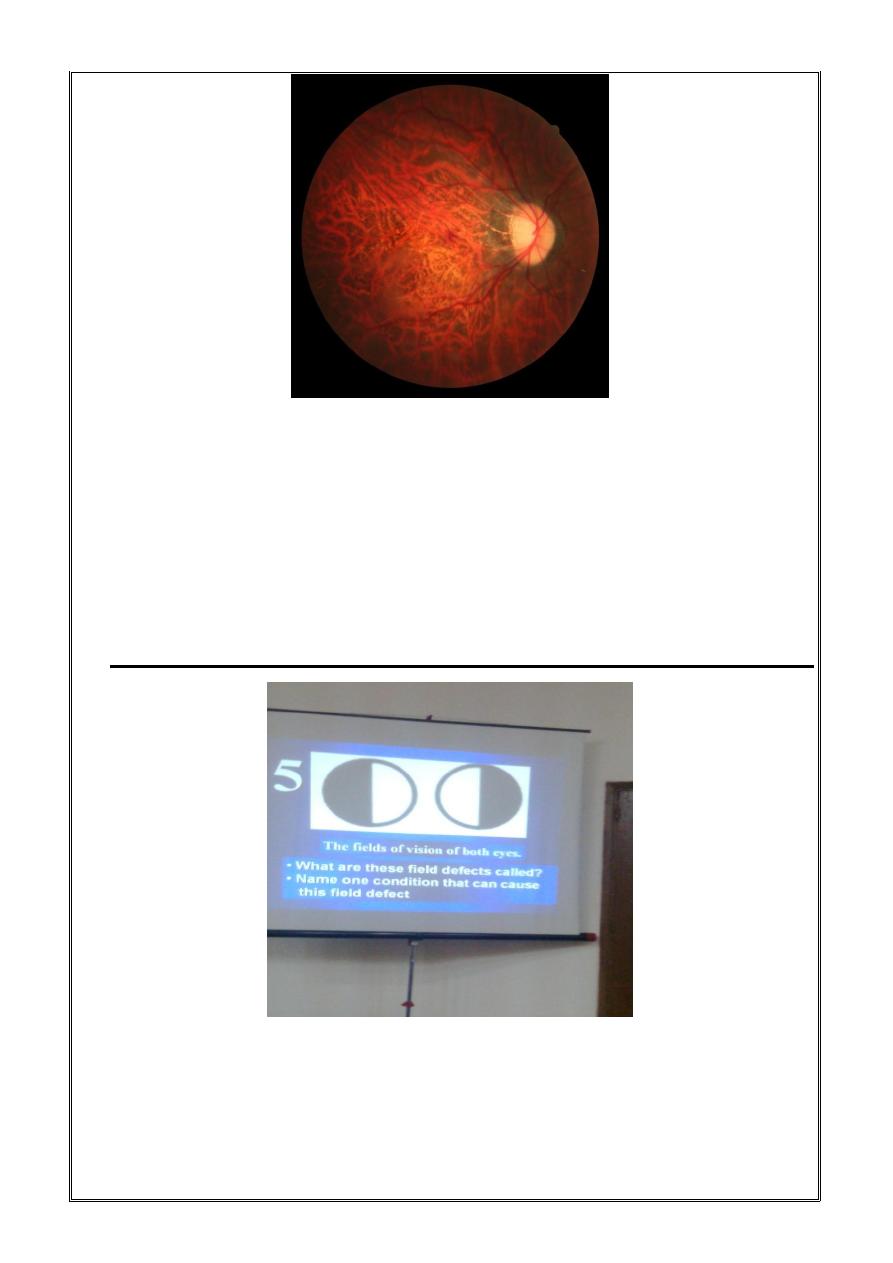
Error of refraction :
High myopia.
Complications:
1) Chorio-retinal degenerations.
2) retinal tears.
3) retinal detachment.
Field defect:
Bitemporal hemianopia.
Cause:
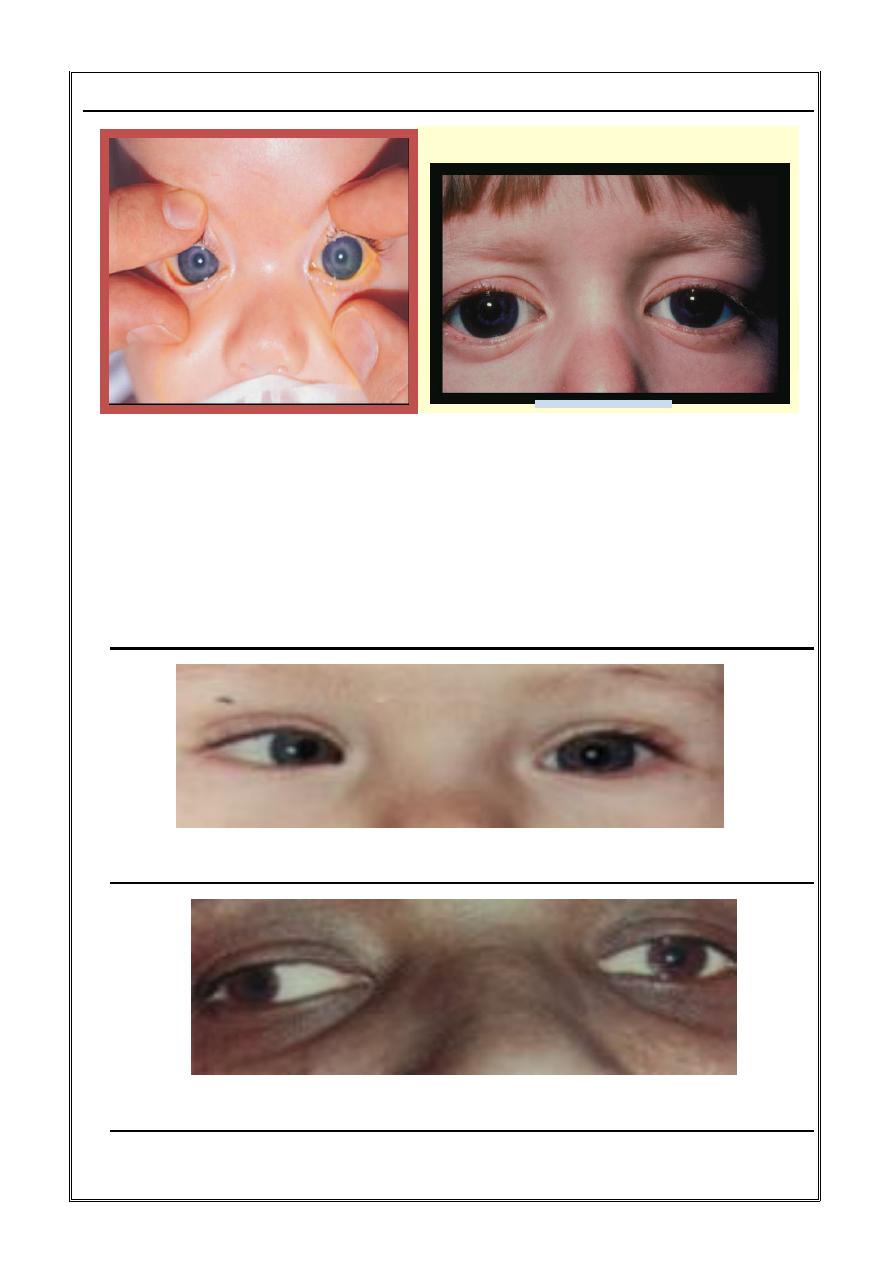
Optic chiasma lesions (nasal fibers damage) e.g. Pituitary gland tumor.
arapaho.nsuok.edu/~fulk/ Images/Img0055.JPG
Examination of neonates (4) buphthalmos
Diagnosis :
Buphthalmos.
Surgical procedures:
1) Goniotomy.
2) Trabeculotomy.
Esotropia: convergent
Exotropia: divergent
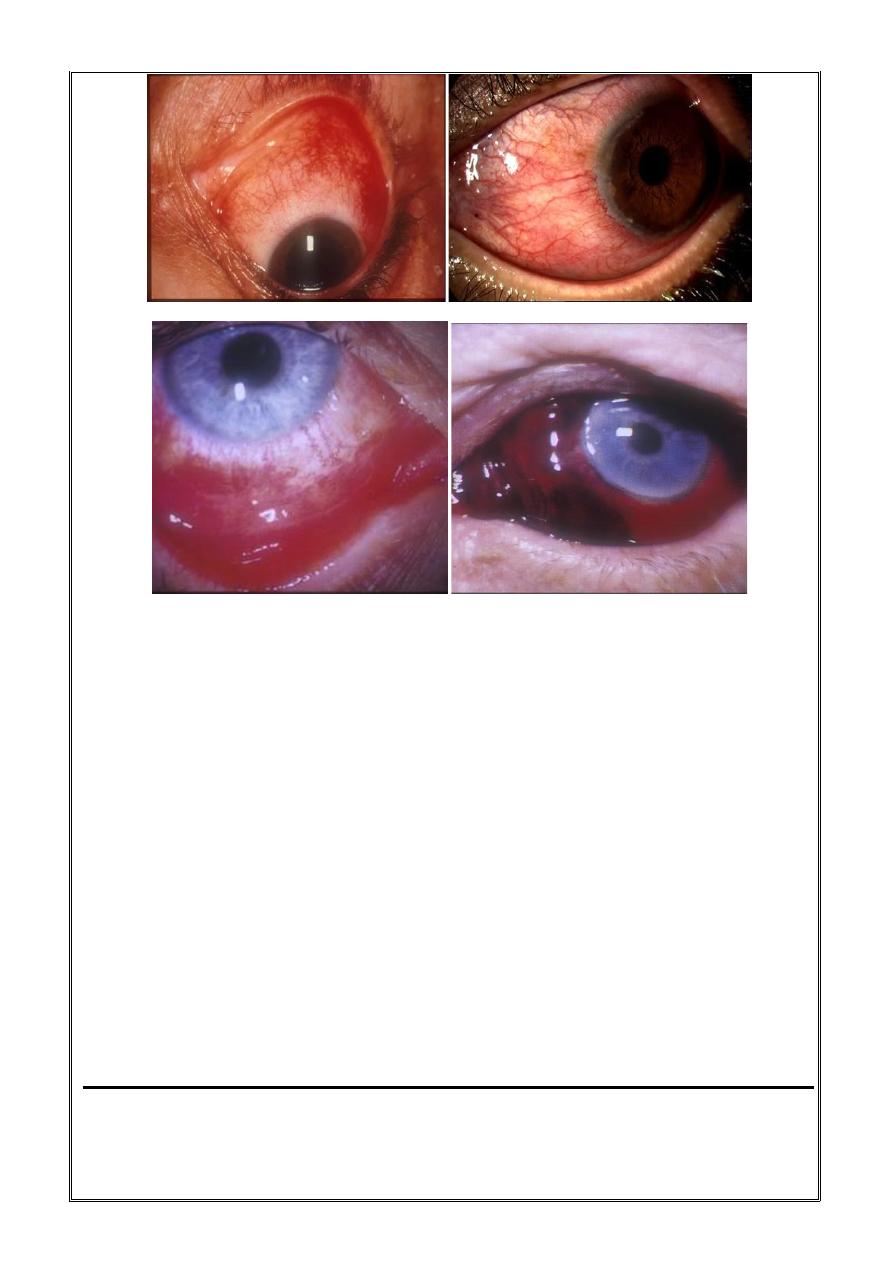
Description:
Red congested eye.
Common Causes:
1- Conjunctivitis.
2- Acute iritis (ant. Uveitis).
3- Keratitis (Corneal Ulcer ).
4- Angle closure glaucoma.
5- Episcleritis (& scleritis).
6- Subconjunctival hemorrhage.
7- Dry eye.
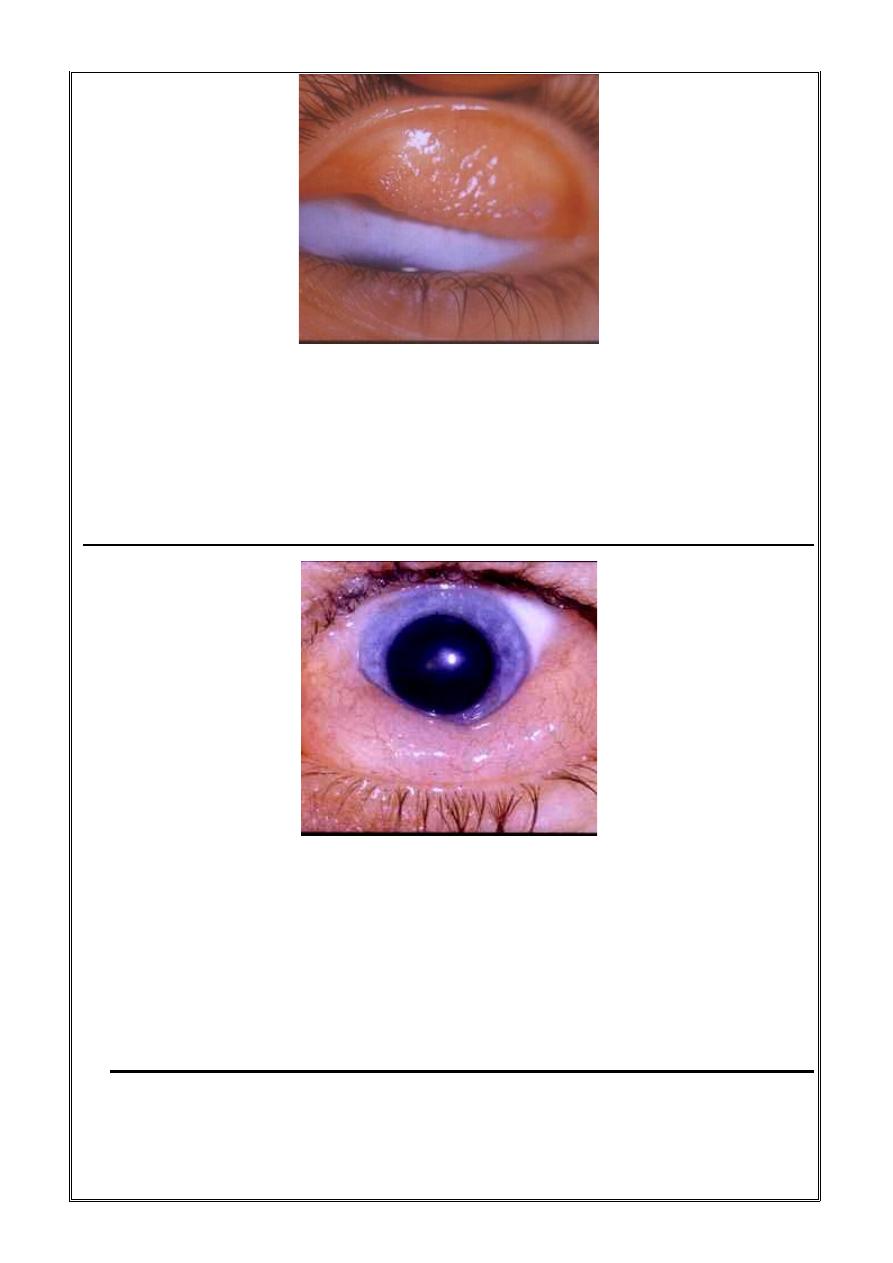
Describe:
Upper eyelid eversion , follicular formation.
Causes:
Trachoma & viral conjunctivitis.
Describe:
Chemosis: edema of the conjunctiva.
Causes:
1) Conjunctivitis.
2) If drainage of blood & lymph from around the eye is obstructed.
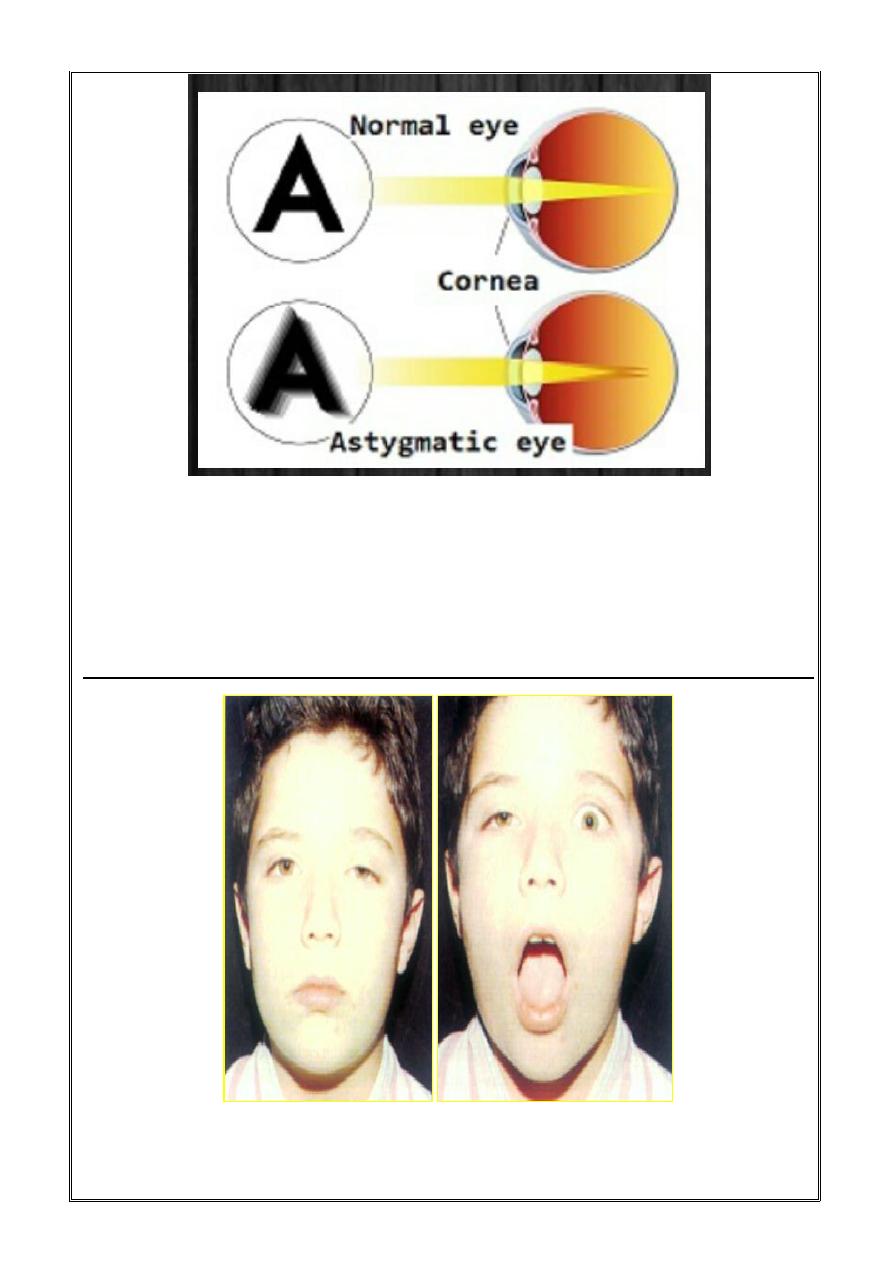
Diagnosis:
Astigmatism.
Treatment:
Cylindrical lenses & refractive eye surgery.
Sign:
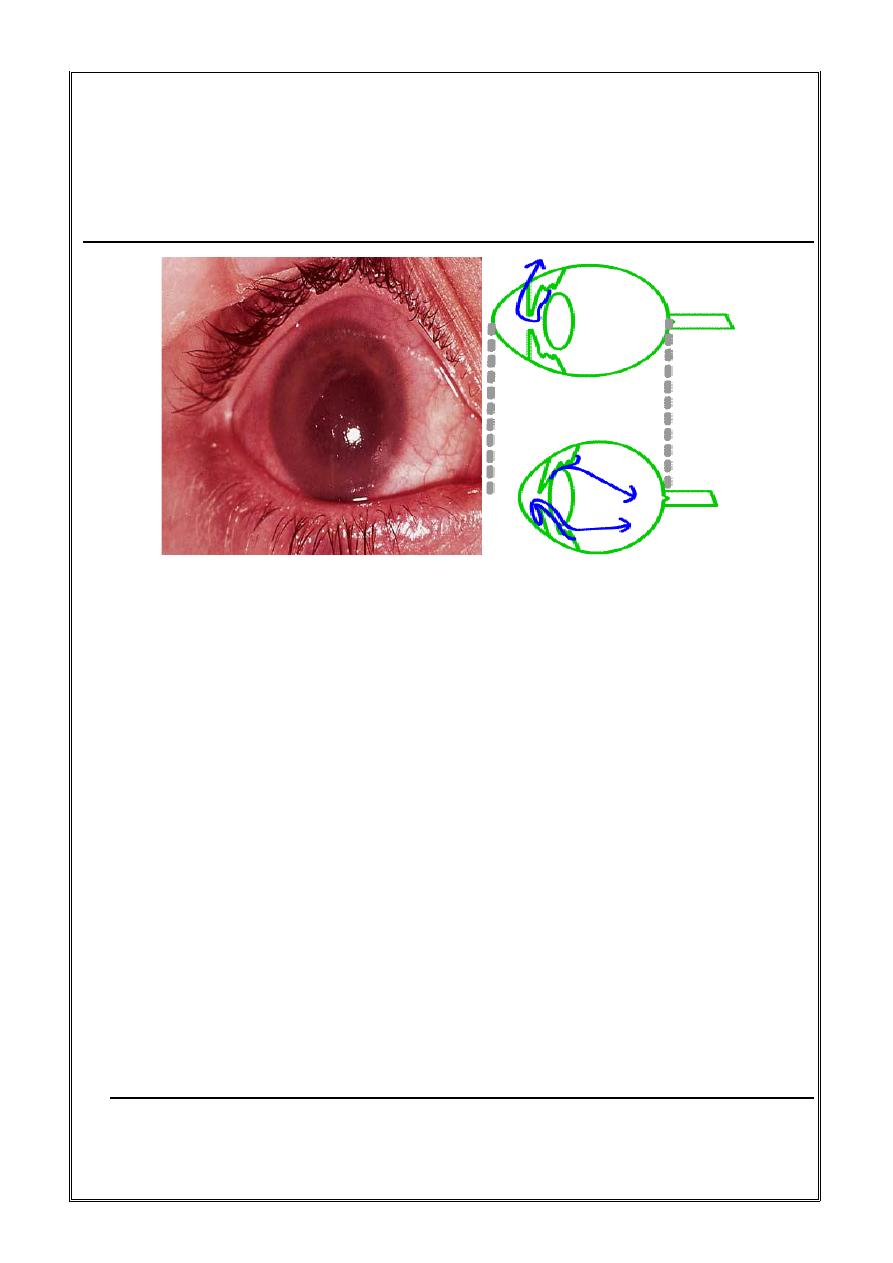
Marcus –Gunn phenomenon
Pathogenesis:
Faulty Innervation (motor fibers from 5
th
nerve reach levator instead of
the 3
rd
nerve).
Describe:
Red congested eye (acute angle closure glaucoma).
Features:
1) Painful red eye.
2) Achy, abdominal pain.
3) Misty vision.
4) Go from light into dark.
5) Small eye, shallow anterior chamber, pupil mid dilated.
6) Iris lens contact.
7) Push the iris forward.
8) Eye feels hard.
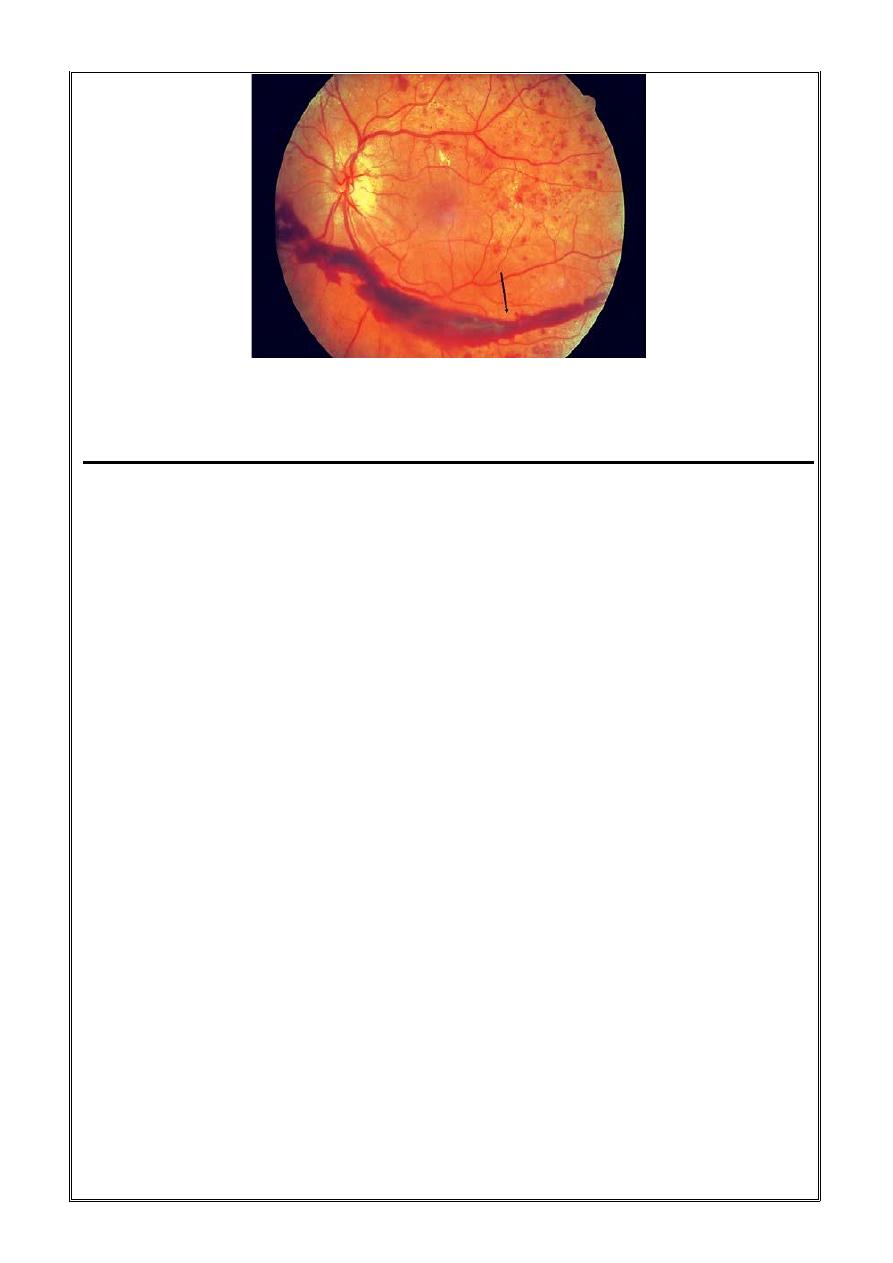
Diagnosis:
Subhaloid hemorrhage(hemorrhage between retina & vitreous.
